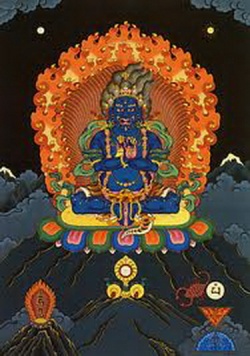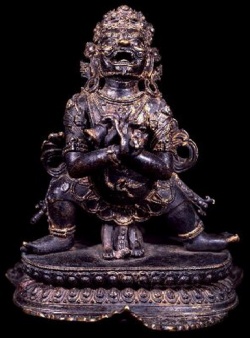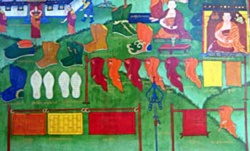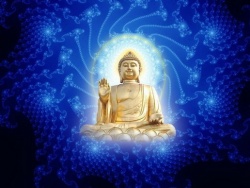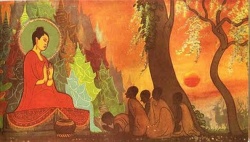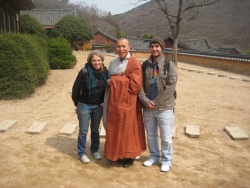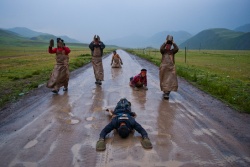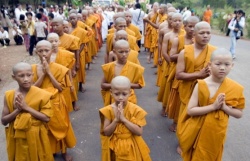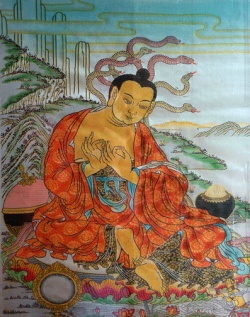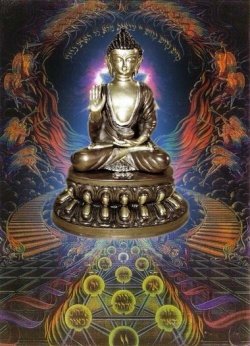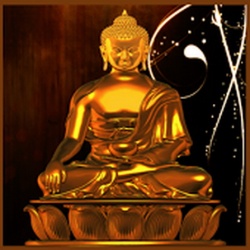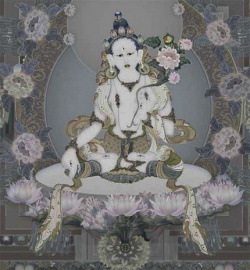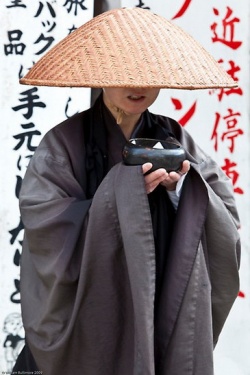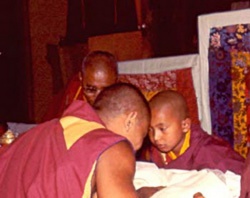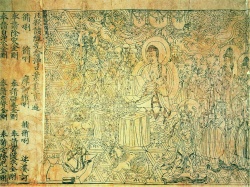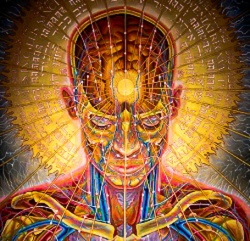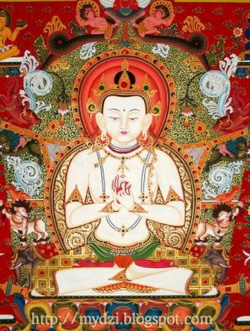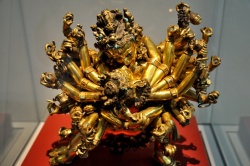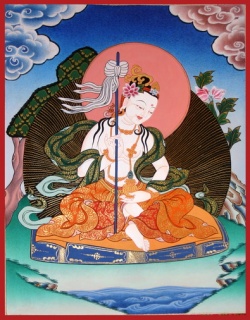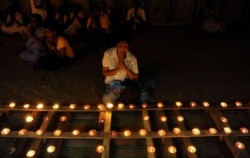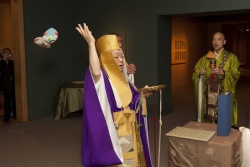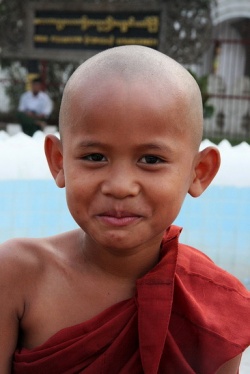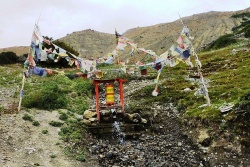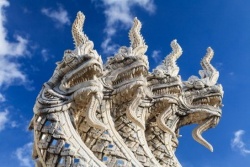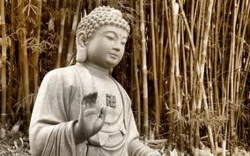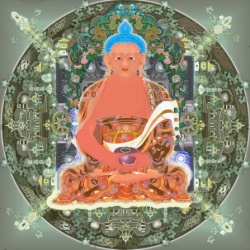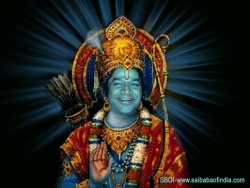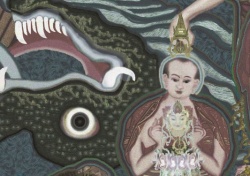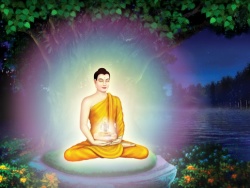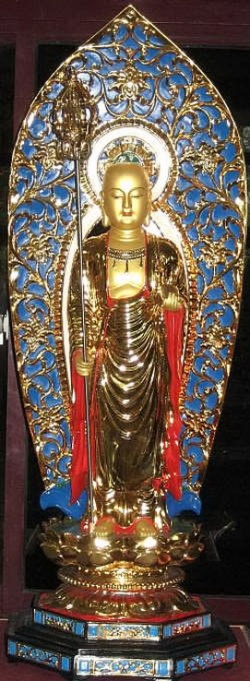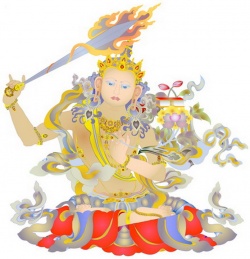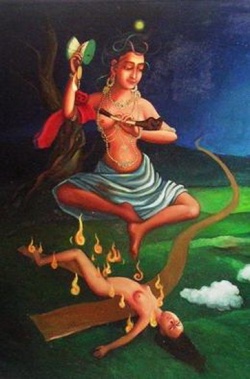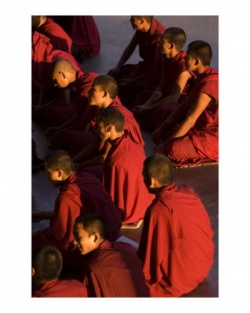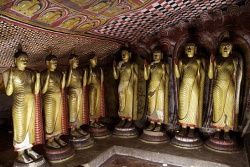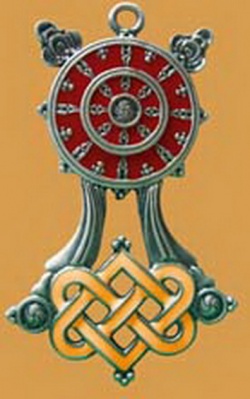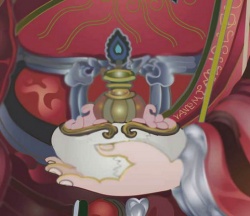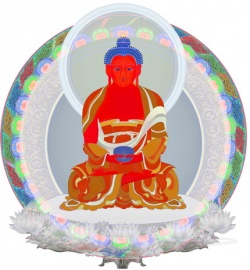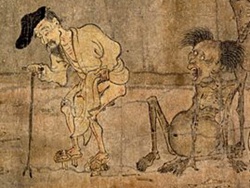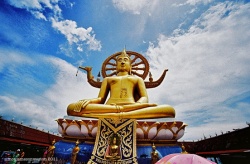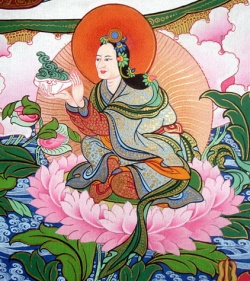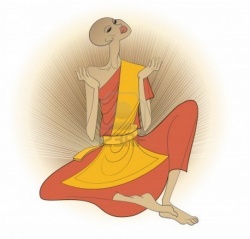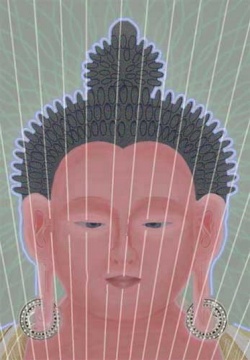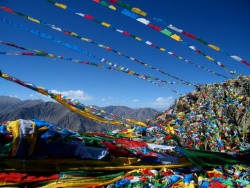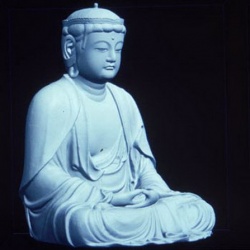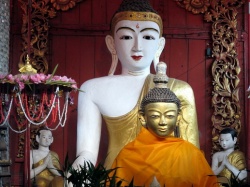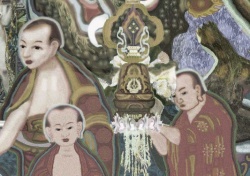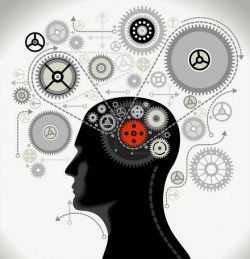Burning Offering to Dorje Khadro
Sadhana: Burning Offering to Dorje Khadro
Refuge
I go for refuge, until I am enlightened,
To the Buddha, the Dharma and the Supreme Assembly.
Due to all the merits created
By my practice of giving and the other perfections,
May I attain the state of a Buddha
In order to benefit all transmigratory beings. (3 times)
Special Bodhicitta Prayer
Especially for the sake of all sentient beings
I must quickly, quickly in this very life
Attain the state of a fully enlightened buddha
For this reason I will now practice the Dorje Khadro burning offering. (3x)
Mantra for dispelling interferes
OM VAJRA AMRITA KUNDALI HANA HANA HUNG PHE
Purifying mantra
OM SVABHAVA SHUDDHA SARWA DHARMA SVABHAVA SHUDDHO HANG
Visualization
The fire becomes void, that is, the wrong ordinary view of the fire as being self-existent becomes empty. The blissful wisdom realizing emptiness manifests in the form of a triangular, blazing
fire. In the middle of the fire is an eight petalled lotus and sundisc with the seed-syllable HUNG at its center. The HUNG melts into light and becomes a five-pronged wrathful vajra, marked by a HUNG at its center. These then transform into the wrathful holy body of Dorje Khadro.
He is black in colour, has one face and two hands, holding a vajra and a bell. He exhibits the mudra of divine wisdom and wearing a crown of five skulls, he snarls into space showing four great fangs. He
is also adorned with a necklace of fifty bleeding heads and a scanty tiger-skin loin cloth. He is seated with his legs forming a circle, and his whole aspect is that of a powerful, magnificent destroyer of all negativities and obstructions.
He has a white OM at his crown chakra, a red AH at his throat chakra and a blue HUNG at his heart chakra. From the latter, rays of light are emitted, inviting Dorje Khadro's transcendental wisdom and the initiating deities from their abode in absolute nature.
DZA HUNG BAM HO
The transcendental wisdom-beings merge with the samaya-being and become non-dual. Thus initiated by these deities, Akshobya adorns Dorje Khadro's crown.
If you have set up an altar, first bless the offerings with:
OM VAJRA AMRITA KUNDALI HANA HANA HUNG PHE
OM SVABHAVA SHUDDHA SARWA DHARMA SVABHAVA SHUDDHO HANG
All is void. Out of the void, from KAM, eight skull-caps appear. In them, from HUNGs, the offering-objects arise, whose nature is voidness, whose aspect is the various offering-objects, and whose function is, as objects enjoyed by the six senses, to give special uncontaminated bliss.
OM ARGHAM AH HUNG
OM PADAM AH HUNG
OM VAJRA PUPE AH HUNG
OM VAJRA DUPE AH HUNG
OM VAJRA ALOKE AH HUNG
OM VAJRA GANDE AH HUNG
OM VAJRA NIUDE AH HUNG
OM VAJRA SHAPTA AH HUNG
OM AH HUNG (3x)
Offerings
OM VAJRA DAKA SAPARI WARA
AHGAM, PADAM, PUPE, DUPE, AHLOKE, GANDE, NIUDE, SHAPTA
PARTI TSA HUNG SOHA
Praise
To you Vajra Akshobya, great wisdom,
The vajra sphere so very wise,
Y our three vajras of body, speech and mind, being the three mandalas,
To you who have this knowledge, Dorje Khadro, I prostrate.
Visualization
Seeing yourself in ordinary human form, a black PAM, seed-syllable of all your negativities, appears at your heart. At your navel, a red RAM, the red fire mandala appears, and beneath your feet a blue YAM, which transforms into a blue air mandala.
Light rays emanate from the PAM, bringing forth all the negativities and obscurations of your three doors, which appear as black rays and are absorbed into the PAM. From below, a blue wind blows and blue air rises up your legs, fanning the fire that blazes at your navel. Flaming rays pursue the PAM, chasing it out through the door of your nose. The PAM takes the form of a scorpion and is absorbed into the sesame seeds. These seeds are then offered to the mouth of Dorje Khadro.
Offering Mantra
OM VAJRA DAKA KHA KHA KHAHI KHAHI SARWA PAPAM DAHANA BAKMI KURU SOHA
As this mantra is said, the following prayer should be made:
All the negativities and obscurations that I have created, and all pledges that I have broken since beginningless samsaric lifetimes SHINTIM KURU SOHA (are all completely purified).
Each time that you say the mantra and make the prayer, also visualize clearly and strongly that you are continuously making offerings.
Offerings
OM VAJRA DAKA SAPARI WARA
AHGAM, PADAM, PUPE, DUPE, AHLOKE, GANDE, NIUDE, SHAPTA
PARTI TSA HUNG SOHA
Praise
In the centre of the blazing wisdom fire stands the dark blue wrathful cannibal, Dorje Khadro. Just by remembering him, all demons and delusions are destroyed completely. To you, Dorje Khadro, I prostrate.
Asking forgiveness
Please forgive all my wrong actions, done while powerless through not understanding, and through not having found the materials to offer.
The transcendental wisdom returns to the absolute nature from where it came, and the samaya-being Dorje Khadro is transformed into a blazing fire.
Dedication
Because of these merits, may I be taken care of and not be separated from
The mahayana guru who shows the infallible path,
And drink the nectar of his speech, not being satisfied with a few words only.
Through the power received by completing the practice of renunciation,
Bodhicitta, right view, shunyata, the six perfections and the two tantra stages,
May I quickly attain buddhahood, possessing ten powers.
By the blessings of the Three Precious Jewels and the nondeceiving master,
And through the might of the nondeceptive, immutable sphere of reality,
May all be auspicious for myself and all others to accomplish all excellent prayers
And quickly achieve the omniscient state of Buddhahood.
Commentary: Introduction
First we are going to take refuge to Guru Shakyamuni Buddha who is the embodiment of all the objects of refuge. Guru Shakyamuni Buddha is the absolute guru, the embodiment of the absolute guru, which has a relation to the relative guru. Buddha is the object of refuge, the guru, the
dharmakaya, the omniscient mind, to say it in a simple way. Guru Shakyamuni Buddha is the embodiment of all Buddhas, Dharma and Sangha. You can also think that the guru's holy body is Sangha; his holy speech, Dharma; and his holy mind, Buddha.
Your own future result-time Buddha or dharmakaya, is the continuation of this present mental continuum. The aggregates on which we label I, on which the self exists, are divided into mind and body. Mind is a formless phenomena, the nature of which is clarity, and which has the ability to perceive objects. Just speaking very roughly, dharmakaya is the continuation of this present mental continuum, this present consciousness.
To achieve that dharmakaya as quickly as possible, we need to purify. Dharmakaya is the state of having finished all obscurations and being separated from all mistakes. It doesn't have the slightest hallucination and can see all the past, present and future reality, the two truths of everything.
Anything that exists is defined by the mind, dependent on the mind, the perceiver, the knower. An object exists when it's actualized by a valid true mind. The definition that an object exists is that it is discovered by a reliable mind.The topic of shunyata, the two truths, is explained in detail in Madhyamika.
To exist, things need to be qualified by three things. If they are not qualified by these three things, they don't exist.
1) The base on which you label should be a valid base. In order to exist, anything you think about or talk about, should have, first of all, a qualified, reliable, valid base.
2) It doesn't receive harm from other valid minds.
3) It doesn't receive harm from the wisdom realizing the absolute truth.
An object exists if qualified by these three things.
As an example (maybe not such an interesting one to hear, but it might be good for the memory): if you pick up piles of excrement and go to sell it in the market, saying: "This is gold", nobody will buy it. It cannot
function as the valid base of gold. You can't get things for it, not even one biscuit. Excrement can't do the function of gold because it doesn't have the valid qualified base. Even though you label it, it's not sufficient.
Then, you see, other people's valid minds see that as not being gold; they see it as excrement. Gold doesn't exist on that base since it cannot do the function of gold. Because it receives all these harms, gold doesn't exist on that base.
So, since the base cannot do that function, there's no gold on that base. The base is not a valid base; it cannot function as gold and receives all these harms, therefore gold doesn't exist. Since gold doesn't exist on that, the wisdom of absolute truth cannot see the absolute nature of the
gold. To see the absolute nature of the gold, gold should exist. The reality of the gold has to depend on the gold; the reality of the gold cannot exist separately from the
gold. It's like a person's character: for the person to be outside the room and his personality or character to be inside would not be possible.
Even though people who sell brass calling it gold may be able to cheat other people in the darkness, or hallucinate them with magic, when the people find out they've been cheated, the brass-sellers get into trouble. Without having any wish or choice, they have to do a long retreat with police outside. If, simply by labelling, something can exist, all these problems wouldn't happen.
Your own future mental continuum, the dharmakaya, is all-understanding and has finished all the obscurations which interfere in fully and directly seeing all past, present and future existences. "All existences" means the two truths which are, in common terms, relative truth and absolute truth.
Dharmakaya sees clearly every sentient being's characteristics: their minds, capabilities and karma. It sees every single different method that can fit to guide and lead each sentient being to temporal and ultimate happiness.
What I was trying to say before was this: "exist" means existing in the object of knowledge. So, you see, it's dependent on the mind. Without the perceiver, or the knower, the thing doesn't exist. If it exists, it should have a perceiver or knower. There should be a valid mind knowing that object. So "exist"
means depending on the knowledge, and depending on causes and conditions. If it is something impermanent, it depends on causes and conditions; if it is something permanent,on parts. Depending on the mind is the basic thing. The perceiver, that which labels, and the base: these cover all existence.
When you hear the word "exist", it itself has a basic meaning: objects exist by depending on things. When we hear "exist", it means dependent. It gives the understanding in the mind of dependent arising. Dependent.
Dependent on the mind because there is a knower saying it exists. Dependent on the base, on causes, conditions and parts. Anything that exists is dependent. By depending on, it exists. That's dependent arising: by depending on things, objects exist.
By depending on the base that can function of 100 rupees, the same paper with all the figures and whatever drawing there is, you can get things which cost 100 rupees by giving that money. On that particular paper which has got those
figures, 100 rupees exists and is able to function. "Able to function" means you can use it; you can get things that cost that much. Even though 100 rupees is merely labelled by people's thoughts, they agreed to accept, to believe, that it is 100 rupees. First of all they got an idea, then actualized a base and labelled it "100 rupees".
This is very good to keep in mind if you want to realize shunyata, if you want to liberate yourself and others from suffering and the true cause of suffering. There's no way to liberate others from suffering without revealing the teachings of shunyata.
Even if there's the paper, the drawing, and all the numbers with however many zeros, if you show it to some primitive person who doesn't know that this is 100 rupees, who hasn't been introduced by anyone before that this is 100 rupees,
he has the appearance of the paper with all those things but doesn't have the appearance of 100 rupees. This is because he hasn't labelled 100 rupees from his own side. Then as he believes what he's taught about what 100 rupees is, he labels: 100 rupees comes into existence for him and he has the appearance of 100 rupees.
That's why so many times there are these words: "things don't exist from their own side." The appearance of the 100 rupees comes from the mind of that person. Buddha's teaching of the two truths is talking about reality; it's very clear, scientific and logical, not made up from religious faith.
You can see how things come from mind. Before there was a base, but only after he labelled is there an appearance of 100 rupees. By the force or the control of mind, 100 rupees exists. It came from that person's mind. This
example is very useful to control not only ignorance, but also attachment and anger. Of course, in general, anything which destroys the ignorance of true existence is the most powerful remedy, like an atom bomb, to destroy other wrong thoughts, but this method can also be used specifically against different delusions.
Apply this experience when the mind has become too dissatisfactory, too much troubled, which results in a lot of confusion to other sentient beings. It leads to disharmony, quarreling and even to killing each other, to wars. Due to one person not controlling his mind, war, the biggest danger to the world, results.
The beautiful object that appears to you is exactly the same as the example of the 100 rupees. Before you label:"That is beautiful", there's no appearance of beauty. First, the mind labels: "That is beautiful", and then there's an appearance of beauty that appears completely as if it's not labelled by thought. That's the reality, but it's not what appears. What appears is the opposite: something which exists neither on that base nor anywhere. The
beautiful person that is unlabeled and exists from its own side is completely empty,, a hallucination. The merely labeled appearance came from your own mind, and on top of this there is truly existent beauty, not merely labeled but existing from its own side. That is what you cannot find if you search from the top of the hair to the feet. You cannot find that truly existent beauty either inside or outside.
Why does the truly existent appearance happen, even though it doesn't exist at all? Even though it's completely empty? Why does it have to appear to us? Why can't we live our lives without hallucinated appearances like that? Put it this way: if you plant a seed in the ground, it grows. What you have recorded in the negative of a film, the machine projects. Putting the machines together gives the projection of whatever is on the film.
Why things appear in the wrong way, why they appear as something other than how they exist in reality; why, even though they're merely labelled, they appear as not merely labelled but as truly existent, is because of the mistake of
not realizing shunyata in past lives. We didn't develop the wisdom to cut off the wrong conception, the ignorance grasping at things as truly existent. We didn't eliminate it by realizing shunyata.
We've planted seeds on the I - some schools say the consciousness, some say the I - and, like a film, there's a potential there so it can be projected. Because of that potential, it projects. There's the habit. Now you can see that this truly existent beauty is a projection of ignorance. Before, it
was merely labelled and came from your mind, but now it's truly existent. That can't be found there. What you are clinging to is your own creation. You are not clinging to something which exists from its own side, even though it appears that way.
Think: "This object of my mind is my own mental creation. I'm attached to my dream." It's the same as a magician transforming people and things, and thinking they're real. It's the same with sense objects - they are your own mental projection. If you follow this way of thinking, the attachment disappears, like clouds in the sky or a rainbow. There's no difficulty in the mind any more. Your own mind, tied to the object and suffering so much, is released from that. Either there's the suffering of separating from and losing the object, or of not having it; even if the object is there, there's the suffering of tightness, of being mentally tied to the object. That mind obscures the open clear mind; it obscures seeing reality. It makes the mind unbelievably gross. It gives no space to experience reality, and to have realisations.
Even if you try to train your mind in the path, you're overwhelmed by the dissatisfactory, attached mind. It doesn't give you any opportunity to even remember the meditation subject. To defeat the dissatisfied mind, shunyata is very powerful; it gives you space in the mind. It's like when you meditate on compassion you feel space for other people.
For anger, also do this meditation on shunyata, on how things are dependent arisings. Meditate on the two truths. Think the same way as I just explained about objects of attachment. You are angry with this ugly person, with the way he looks at you, with the way he puts his words together. On that, you've labelled "bad". Even if you haven't labelled the word "bad", the person is appearing that way, as bad and ugly. It's so painful to the mind.
It's very clear that there is no way he's bad from his own side. It's very clear that the appearance comes from your own mind. If you think in this way, then as before, you don't find any reason to cling to your own wrong-conception projection. When you find yourself arising anger and thinking to harm others, you feel completely silly. You feel that it's nonsense. "I'm fighting with my own projection that I've created. I want to fight with and kill what I've created. I want to kill myself!" Then there's no choice - the anger disappears. You find it completely silly.
This is also a powerful way to cut off the jealous mind. Meditating on dependent arising and emptiness is like an atom bomb; it immediately brings mind peace. It stops these unbearable, painful minds and gives space so that there's mental relaxation, happiness and release from suffering.
The purpose of saying this is to actualize your future dharmakaya now. Not only because you are suffering, but especially because other sentient beings are suffering and need your help. And the other sentient beings who are suffering are numberless. Because of that, we need to actualize dharmakaya right now.
With this dharmakaya you can perfectly guide sentient beings with perfect methods all the time, without the slightest mistake. The quicker we achieve dharmakaya, the quicker we actualize it through the practice of Dharma, the quicker we can guide sentient beings, and the shorter they suffer. The longer it takes, the longer other sentient beings have to suffer. Even one sentient being suffering is too much. Shakyamuni Buddha, by achieving enlightenment uncountable ages ago, has already liberated uncountable numbers of sentient beings from samsara and led them to peerless happiness, to enlightenment.
If we had become enlightened by practicing Dharma as Guru Shakyamuni Buddha did, by now we could have liberated countless sentient beings from the sufferings of samsara and led them to peerless happiness, to enlightenment. But because we didn't practise like that, because, in the past, we didn't change our minds from the selfish attitude to cherishing others, and are always living with self-cherishing thought and following it, so far the mind has been completely empty of realisations and qualities. Besides not having the qualities of Buddha, there's not even a quality of the bodhisattvas or arhats. There's not even the quality of shi-nä, calm or tranquil abiding.
Besides being unable to help others and free them from suffering, even we ourselves are suffering, caught in the quagmire of samsara. We are not liberated from samsara, not free from suffering. This is the result of the mistake of following the selfish attitude. If we had done as Guru Shakyamuni Buddha did, if we had changed our minds much earlier, then by now, so many sentient beings who are dependent on us would be enlightened. They would be free from samsara, in ultimate happiness. But because this change of attitude didn't happen, they've had to suffer until now. You can understand this by using Guru Shakyamuni Buddha's life story as an example. He became enlightened countless aeons ago by changing this attitude, and so has led uncountable numbers of sentient beings to temporal and ultimate happiness, especially ultimate happiness.
So now, in order to become Buddha ourselves, the result-time Buddha, Dharma and Sangha, we need to change our selfish attitude to the attitude which is the source of all happiness, ultimate and otherwise, for ourselves and others. Achieving Dharma within our mind, the true path and true cessation of suffering, is the result-time refuge. Through achieving that, we become Sangha and through that we achieve our own result-time refuge object: Buddha.
Then we can guide sentient beings perfectly. For that reason we need to rely upon the cause refuge of Buddha, Dharma and Sangha: Dharma, which is in the holy mind of Buddha and Sangha, the realized beings. By the power of these objects and, from our side, putting effort and relying upon them, we are able to actualize our own result-time Buddha, Dharma and Sangha.
When we change our attitude from the selfish attitude to cherishing others, bodhicitta, that is holy Dharma. But to have the holy Dharma we need to rely upon the cause refuge of Buddha, Dharma and Sangha and to receive blessings within ourselves. Actually, when we are able to do the practice of controlling the self-cherishing thought, that is receiving blessings. Being able to control the self-cherishing thought itself is the action of Buddha. Being able to do that is the action of Buddha which is within our minds.
To actualize this Dharma within us, we need to purify the obstacles; we need to purify the negative karma, obscurations, downfalls and degenerated samayas. Here, the particular purification method is Dorje Khadro, offering sesame seeds to the Buddha Dorje Khadro. Relying on Dorje Khadro is a particularly powerful method to purify obscurations and negative karma.
I thought to give the explanation of this practice of Dorje Khadro since there are no commentaries available in English. Even if you can't actually receive the commentary from a lama, at least there'll be material available that can help you develop clear understanding so you know how to do the practice. So I thought to go over the commentary in a little bit more of an elaborate way and explain whatever I can understand from the text.
Commentary: Preliminaries
Take refuge in Buddha, Dharma and Sangha, either visualizing Guru Shakyamuni Buddha as the embodiment of all refuge objects, or the elaborate visualization.
I go for refuge until enlightenment to Buddha, Dharma and Sangha. Due to all the merits created by myself and others by practicing charity, morality, patience, perseverance, concentration and wisdom and here, particularly due to my listening to the teachings, may I achieve the Buddhahood stage in order to benefit all transmigratory beings. May I achieve enlightenment to be able to benefit transmigratory beings.
Dro la means transmigratory beings. Why dro la? Using ourselves as an example, now we are human beings but we cannot be human beings forever. Like the airport that we pass through, we are here for a short time, in transit. We don't live in this body forever. We live in this body for a short time and then take other aggregates. We leave those and again take other aggregates. Wherever we and the sentient beings in the six realms are born, it is only for a short time. It is not forever. Like the stations that we go through, we stop there for some time, then leave that station and go to another one.
Relate it to yourself now. You see, we migrated to this body from past lives by being under the control of karma and disturbing thoughts. Now again, by the force of karma, we will migrate to the next life, from these to other aggregates. That's why it says "migratory beings". From one realm to another realm, from these aggregates to other aggregates, we experience all the sufferings of that realm, the true sufferings. It goes on and on like this until we cease karma and disturbing thoughts which bind us to the aggregates, to samsara.
The other sentient beings who are suffering in the six realms are the same: they are transmigratory beings. So when we say dro la, "transmigratory beings", it expresses that they are suffering, which makes more compassion rise, rather than saying "sentient being" - somebody who has a mind - which may not rise that much feeling, that much compassion.
Relate the words "transmigratory being" to yourself, for renunciation of samsara, then relate it to others. Thinking of the meaning of dro la shows the entire suffering of the twelve links, the whole evolution of samsara from the ignorance hallucinated as to the nature of the I, to death. Dro la, transmigratory beings, explains the whole true cause of sufferings, the whole evolution of the sufferings of those beings. Hearing that word makes you see how sentient beings are suffering in samsara. Saying it makes compassion rise. It gives more feeling if you really think about the meaning. It's a word expressing how pitiful the sentient beings in the six realms are.
Due to these merits of listening to the teachings and so forth, accumulated by myself and other sentient beings, may I achieve enlightenment in order to benefit all transmigratory beings. At any rate, I must achieve the state of omniscient mind quicker and quicker for the sake of all those pitiful transmigratory mothers who equal infinite space, and have been kind to me for numberless rebirths. Therefore I'm going to take the oral transmission of the very profound, powerful method of purification - offering burning puja to Dorje Khadro.
This is one of the very profound practices for purification, regarded as a golden Dharma, a precious one. It is Lama Tsongkhapa's heart practice, and his followers practiced it knowing it to be extremely beneficial.
The Eater, Vajra Daka. "Eater" means eating your own negative karma. You purify negative karmas by offering them in the holy mouth of the deity, Dorje Khadro. Dorje is the vajra. The definite meaning of vajra is that transcendental wisdom of non-dual bliss and voidness that is the dharmakaya, the absolute guru. In order to benefit sentient beings, especially, to purify negative karma, obscurations, downfalls and the degenerated samayas of tantra, this dharmakaya manifested in the sambhogakaya aspect. That is the definite meaning of vajra: the transcendental wisdom of non-dual bliss and voidness. That dharmakaya, or absolute guru, manifested in the sambhogakaya aspect, took that form, to lead sentient beings to enlightenment by purifying them.
(Rinpoche shows the picture of a Dorje Khadro statue in the English translation of the sadhana.) When we went to America the very first time, straight from Kathmandu to New York, the student in whose house we were staying was using the statue's mouth to hold lighted incense. By Lama's kindness in having given the explanation of this practice, I was able to recognise the deity. I don't know how she got the statue. This is a picture of that same statue. Her house was in Brooklyn, in New York - a very noisy place. It was a long, long journey in a Pan Am jet, and they gave food every two or three hours. When we reached her house, the whole building was going like this (up and down) in my view. It was very near the street and there were incredibly many vehicles. That was our first time in a large city.
The definite meaning of vajra, the dharmakaya, the transcendental wisdom of non-dual bliss and voidness, that holy mind is unified with that holy body. In tantra terms, this is the unification of holy mind and holy body. The definitive meaning of vajra took the form, the interpretive meaning of Dorje Khadro, Vajra Daka. This is the unification of that dharmakaya, that transcendental wisdom of non-dual bliss and voidness, and the holy body. This manifestation, Dorje Khadro, is the unification of holy mind and wind.
So, the meaning of Dorje Khadro: Dorje is the transcendental wisdom of great bliss. Kha is space, dro is going. This doesn't mean ordinary space; it means the space of shunyata, the clear-light emptiness, directly perceiving this clear-light emptiness. This is the meaning of khadro.
The base is the vajra, the transcendental wisdom of great bliss, which covers, directly perceives all the clear-light emptiness. Khadro means traveling in space. Dorje, that transcendental wisdom of great bliss, is covering all. Dro means perceiving all and, in that way, being oneness with it; abiding in the clear-light emptiness and being oneness with it, by having completely cut off the subtle dual view. Abiding in the clear-light emptiness like having put water into water, is called dro, traveling.
Another meaning of Dorje Khadro is this: Vajra, the transcendental wisdom of great bliss and emptiness, is abiding in the clear-light emptiness and then out of that, manifests in different forms like Dorje Khadro, Guru Shakyamuni Buddha and Tara, various innumerable forms to guide sentient beings. Out of that, from that. Kha is the space of emptiness and dro means from there, taking the form; by going there, taking the form.
These meanings are very secret tantric teachings: very important, very secret points. But if the listeners have faith and the intention to take initiations and practise, then even if they have no initiation now, it could be beneficial to know these explanations. Dorje Khadro has very extensive meanings and to understand them, you need to understand the path and the base, the two truths.
So here's just a little story, before going over the commentary. Kachen Yeshe Gyeltsen was Lama Tsongkhapa's disciple, who did incredible work for sentient beings and the teachings. He received the lineage of this practice from Lama Tsongkhapa. There are several practices that Manjushri taught Lama Tsongkhapa, and Dorje Khadro might be one of those, but I'm not sure.
So the great lama, Kachen Yeshe Gyeltsen said: "The burning offering to Dorje Khadro is very powerful in purifying general obscurations and negative karma." Regarding negative karma, it doesn't have to be killing animals or hurting somebody straight, with speech. Negative karma is not watching your mind. As mentioned in The Eight Verses by Kadampa Geshe Langri Tangpa: "In all conducts, all the time, you should examine your own mental continuum."
We are always doing something: eating, sitting, sleeping, whatever. Examine the mental continuum in all actions. When delusion rises, it immediately makes you evil. May I be able to immediately dispel it, without even a second's delay." Once you recognise the delusion, without delay, without allowing the delusion to defeat you for even a minute, even a second, you defeat it. It means immediately.
Why "immediately"? Why is it so important to immediately defeat and dispel the delusion? In the Bodhicaryavatara by Shantideva, and in many other teachings, it says: "By rising anger for one second it destroys one thousand times the merit you have accumulated by practicing charity and so forth." Destroys. Not only that, but:"All the results of the good karma you are about to experience are delayed for a thousand aeons." So there are two things.
Therefore, there's incredible danger. If you're late by even a second to control powerful delusions like anger or heresy, the experience of those results is postponed for a thousand aeons. And even that is dependent on the object with whom you get angry; it depends on the level of his or her mind. All the results of those good karmas - temporary happiness and enjoyments, and ultimate happiness - you won't get for many thousands of aeons. So without a delay of minutes or seconds, you should immediately control and destroy the disturbing thoughts.
How do you destroy them? With method and wisdom. With shunyata, as I explained in the previous talk. Then there are other methods like generating compassion, remembering impermanence and the perfect human rebirth, its meaning and preciousness. Remember how this life is highly meaningful, how you can achieve the three great meanings. Use all these methods. By remembering these things, immediately anger and those disturbing thoughts disappear. It doesn't give them an opportunity to arise.
If this practice of continuously watching the mind, the mental continuum, in every action, is not done, what happens is that delusion arises and all the actions are done out of delusion. It's as if all the food you eat is mixed with poison. Instead of benefiting, in the long run it causes danger and harm. On the other hand, if you watch the mind, you're not giving delusions a chance to overwhelm you; you're not giving them the chance to take over and conquer you. In this way, there's a possibility for the mind to become virtue; everything becomes beneficial, like eating only food which is medicine. All the actions become medicine; they become only the causes of happiness, both temporary and ultimate.
So it seems that constantly watching the mind is the most important thing. Otherwise, there's no other way to control the mind, no way to keep the mind in peace, and for all the actions to become virtue, the cause of happiness. Watching, constantly watching, is the most important. The advantage of watching the mental continuum in all actions is that you're able to recognise when delusion is about to rise, able to immediately recognise the danger that's going to come. Then you can immediately use your weapons, your meditations, to destroy the delusion. Use whatever understanding of the teachings you have to destroy the delusions. This is the advantage of always watching, of always being mindful. This is very good.
Now, where do you get the inspiration, encouragement and energy to watch the mind continuum all the time? To not be lazy? That's why these very simple meditations on perfect human rebirth, on impermanence and death (especially that death can happen at any moment) are so important. These are what should be done to be able to be thoughtful all the time. They are simple, easy to understand and easy to feel.
To think like this is very useful: "Every moment, every second, every minute, every hour, from now up to enlightenment, I am responsible. Not only for the happiness of this life up to death, however many years I live - forty years, thirty years, a few years or a month - not only for that, but for however long I'm going to be born in samsara, for all my future lives up to enlightenment, I am responsible. I am responsible for the whole thing now, for all my future lives' happiness. I am responsible in every minute. Every minute. This is a huge responsibility. I, who have this human body, am responsible. This I having this human body is responsible every minute for how it's going to be in the future, how much suffering and how much happiness up to enlightenment. Whatever I think, whatever I do with body, speech and mind is a great responsibility."
Thinking of your own happiness is a great responsibility. Now, that is nothing. That is nothing. When we just think of ourselves, we feel it's so unbelievably important to have happiness, but we are responsible for more than just that. I have been mentioning compassion from the very beginning: how we are responsible for freeing all sentient beings from suffering, and leading them to happiness, to enlightenment.
We have to help simply because they have minds, and we know they have suffering, and because they are so many in number. On top of that we have the opportunity to help. Then on top of that there are many more reasons why we are responsible: because of their being our mothers numberless times, because of their being kind, and giving the three types of extensive kindnesses. There are many reasons. The three types of extensive kindnesses are: granting all temporal happiness, all liberation and all peerless happiness. All three you receive by the kindness of sentient beings. Therefore, we're responsible to obtain happiness for and free from suffering each sentient being.
It's good also, when we see other suffering beings or creatures, like spiders and slugs, to think: "Those beings who are suffering so much are my responsibility." Look at those creatures like slugs, that come in the rainy time, and think: "We are the same, wanting happiness and not wanting suffering. We are the same. We just have different bodies. But even among humans there are different kinds of bodies." Feel that we are the same as all those creatures. If we think of their suffering, if we analyze how being born like that would be, it becomes the cause of renunciation. It gives us inspiration to as quickly as possible be free from samsara. And when we think of how unbearable that suffering is on that being, it becomes a cause of compassion.
Feel the responsibility: "If I don't quickly become the perfect guide, having finished all the mistakes and having all the qualities, these sentient beings will be suffering for a long time." Feel the responsibility. That's very good. We should feel the responsibility for all sentient beings. Every moment, every hour, this "I" which has this human body has a responsibility. The only thing, the only way, the only method, the only solution, is Dharma. To fulfill that responsibility there's no other method, only Dharma. Only Dharma.
To become a perfect guide, having finished all mistakes and having all qualities, depends on day-to-day life - every hour, every minute, not falling under the control of delusion. As Gyelwa Ensapa said: "It's important to keep the mind in the essential practice of guru devotion, renunciation, awareness in karma, moral conduct, compassion to others, emptiness and dependent arising." Otherwise, you see, if we don't practise mindfulness, every single delusion takes over our mind, and everything we do becomes a true cause of suffering. Thinking in this way gives you inspiration to be mindful, to be careful all the time.
Even if there's no anger or jealousy, the one that constantly arises is attachment. And among the attachments, the constant one is attachment to the happiness of this life. We get up and get dressed for the happiness of this life. We have breakfast for the happiness of this life. Then lunch, for the happiness of this life. And again dinner, for the happiness of this life, the happiness of the self. It's only for the self in this life.
Even washing is for the happiness of this life. Everything becomes an action of attachment for this life. Every single thing, whether you sit, stand or walk, is an action of attachment for this life. Negative karma does not necessarily mean killing someone, endangering life, hurting or causing wounds. If we don't watch the mind, if we don't protect the mind, whatever we do is constantly creating negative karma because attachment is like the ocean, a flood that takes all the city, covering the houses. Attachment constantly controls the mind like that.
The virtuous mind arises only sometimes, so it's very important to purify negative karma. Because we have so many negative karmas, Dorje Khadro is very important; it is a powerful method to purify obscurations and negative karma.
In regard to vows, it's very difficult to not break the root vows, but even if you don't, the branches are broken like rainfall, especially tantra. Lama Atisha said he rarely received the vice of breaking the secondary vows; it happened only sometimes. But he received the vice of breaking the secondary tantra vows like rainfall. If it was like that for him, then there's no question for us.
By taking maha-anuttara initiations, we take all those samayas of the five Dhyani Buddhas, and the mother tantra samayas. We have to remember them all the time. Breaking the tantra secondary vows is 100,000 times heavier than breaking the bodhisattva vows. And breaking the bodhisattva secondary vows is 100,000 times heavier than breaking the root pratimoksha vows. Dorje Khadro is particularly to purify all these degenerated samayas; to purify and revive them, and also to prevent any obstacles in the practice. This Dorje Khadro practice is highly admired to purify and to stop obstacles, and it is regarded as having great blessing.
"Lama Tsongkhapa, the great venerable omniscient one, handed this meditation practice to his very heart son, Kedup Gelek Pelsang. This is a special technique so have stable faith in it, and then practise." That's what the bhikshu Kachen Yeshe Gyeltsen, who is the holder of Lama Tsongkhapa's teachings passed from ear to ear, said. Penchen Palden Yeshe said that in the past this kind of teaching, this meditation technique, wasn't written down; it was kept very secret.
This teaching of Lama Tsongkhapa's is very much admired. It is a powerful method to purify all obscurations and negative karmas, especially degenerated samayas. It is mentioned in the root tantra teachings, and in the teachings of many other great yogis. Lama Tsongkhapa and his disciples, the Pelden Segyu" tantric college lamas and the holy lineage lamas of the Ensapa teaching which is passed ear to ear, keep this as a heart practice.
If the practice is related to some story, it's beneficial for the mind. Before Mintröl Ngawang Thinley Lhundup became a high lama and was just a simple monk, he asked Penchen Losang Chökyi to make an observation about what his future rebirth would be. Penchen Losang Chökyi Gyaltsen told him that he would be born in the blissful realm of Amitabha. After this, Mintröl Ngawang Thinley Lhundup lived in a monastery and was given the responsibility of being the teacher of Hamdong Kamsin. Maybe it was Sera Monastery. Each of the main monasteries of Sera, Gaden and Drepung has two divisions, kamsin, depending on which country the people come from. So this lama was looking after the responsibilities of Hamdong Kamsin.
Later he again he asked Penchen Losang Chökyi Gyeltsen, who is the one who put Lama Chöpa together, where he would be born next life. And this time the Penchen Lama wrote back: "You will be born in the narak." This shows that because that lama lived in the monastery, he received a lot of pollution by enjoying sangha things. If you eat sangha food and use things belonging to sangha without doing your responsibility and practicing Dharma well, you receive much pollution, and you get born in the narak.
After hearing this, MIntröl Ngawang Thinley Lhundup did much Dorje Khadro practice, offering burning puja to purify the negative karma. And after doing all this Dorje Khadro practice, he asked Penchen Losang Chökyi for the third time where he would be born, and he got the answer that he would be born in the blissful realm.
In the Charya tantra root text, I think it says: "By having done the fire puja, even those who have the negative karma to be born in the great narak (I think it's the hot narak - not the ordinary one, but the great one) will get liberated from those negative karmas. Without doubt that being will be born as a happy transmigrator." Sherab Gyatso, a very high lama who is the holder of the whole teaching and wrote many scriptures, said: "The benefit of offering burning puja to the eater, Dorje Khadro, is that it purifies so many negative karmas. It is so important to rely upon a practice that definitely purifies such as this."
This Dorje Khadro commentary is based on a commentary written by Penchen Losang Chökyi Gyeltsen. There are small differences among the various ways of doing this practice. There are elaborate and abbreviated practices of offering burning puja to Dorje Khadro. From among these teachings by many different lamas, this particular commentary is based on Penchen Losang Gyeltsen's. There are three outlines: preliminaries, the actual body and the completion.
Preliminaries
On a flat tray or a plate, make the black sesame seeds in the shape of a scorpion. In Tibetan, scorpion is digpa rachen. Digpa means evil deeds and rachen means having horns. Generally, the more ugly and terrible-looking a sentient being is, the more negative karma he has created. How ugly and terrifying a being is, is the result of negative karma. Because of the name "evil one having horns", the sesame seeds are made in the shape of a scorpion to make it effective for the mind. When His Holiness the Dalai lama gave the commentary, he said to mix the seeds with butter. If the seeds are mixed with butter, make the shape of a scorpion and break off pieces. If the seeds are dry, pile them in a scorpion shape with horns.
The fire place is like the pacifying fire place. When you do fire pujas, there are different types of fire places according to the four types of actions. The pacifying fire place is to pacify hindrances, disease, spirit harms and obscurations. The increasing fire place is to increase wisdom, life, fortune and wealth. The controlling fire place is to destroy evil-doers who harm many sentient beings, the teachings and holy beings. "To destroy" means to separate the consciousness from the body and transfer it to a pure realm. So, according to the action you want, there are different fire places.
For the pacifying fire place, the pot you put the fire in should be white in colour. If it's black, paint it white or put white mud on the outside. The shape should be round, and not broken. Into that put coals that are not smoking. If it's possible, in order to have a clear visualization, put a Dorje Khadro statue facing you.
In front of the fire place, perform the offerings: the two waters, one for drinking, one for the feet; flowers to offer to the crown; incense for the nose; light for the eyes; scented water for the heart, and music. For music, you have damarus and bells, so you don't need to offer music on the altar; you offer by actually playing it. The flowers are offered in garlands like Indians offer at marriages, or to their kings and to welcome visitors. All these offerings are set up according to the tradition of how they were offered to Buddha when he was in India.
If all these things, like making a scorpion shape out of seeds, the pot and the statue can be done, it's very good, more perfect; but if you can't do them, nothing is missing.
Then generate the motivation.
Next, visualize in front of you, at the same level as your forehead, a throne raised up by either four or eight snow lions. On top of this is a lotus, then a sun, and above this is Guru Dorje Khadro.
These four lions signify the qualities of Buddha: the four fearless states. I don't remember the meaning if there are eight lions. The lotus and sun disc mean the actualization and completion of the whole path of method and wisdom. In particular, when related to maha-anuttara yoga tantra, the lotus signifies the illusory body, which is method; the sun signifies clear light, which is wisdom. Through these you achieve dharmakaya and rupakaya.
I explained dharmakaya, the definite meaning of vajra,before. Rupakaya is the holy body which is called Dorje Khadro, the holy body which is a manifestation of the definite meaning of vajra. Lama Dorje Khadro sitting on top of the lotus symbolizing method, the illusory body, and the sun which is wisdom, the clear light, signifies the unification of the two kayas - the achievement of the holy body and holy mind. The throne, lotus and sun together can signify the three principles of the path: renunciation, bodhicitta and shunyata. I haven't seen an explanation with the throne included, but that meaning could be possible.
When you say "Guru Dorje Khadro", think that there's this wrathful aspect but what it is, is the transformation of the absolute and relative guru. Dorje Khadro is the transformation of the relative guru, who is the transformation of the absolute guru. "Guru" means both absolute and relative. Relative means just the form which we see, the ordinary form taken by the absolute guru. It's saying here that that is the way to meditate.
Like the Lama Chöpa or refuge merit field visualization, Guru Vajra Daka is surrounded by the triple gem, all the Buddhas. There are all the lineage lamas, the four tantra deity aspects, sutra aspect Buddhas - the thousand Buddhas of the fortunate time, the seven medicine Buddhas and the thirty-five Buddhas - then the arhats, dakas and dakinis, and protectors.
In front of each Buddha, you can visualize each of their realisations, of having understood the words and meanings, in the form of texts. This is how it's visualized in the refuge merit field. Behind Lama Dorje Khadro are all the texts, piled up nicely, with only the brocaded title end visible, like they keep texts in monasteries. However you visualize, think that this is the Dharma refuge object: all the Buddhas' understandings and realisations in the form of scriptures.
With the thought of fear (you can call it useful fear, or understanding fear) and a feeling of repentance, take refuge. You're afraid because you, and all the sentient beings around you, are suffering the general sufferings of samsara and particularly those of the evil transmigratory beings like the naraks. You have fear of this result and the cause of it, of experiencing it now and of having experienced it in the beginningless past. Generate this thought of fear and, with it, faith that this object of refuge has the power to guide you and all sentient beings from these fears of true suffering and the true cause of suffering. The downfalls and negative karma are the true causes of suffering. You should be like a very seriously ill patient in danger of death, who is completely relying on the most qualified doctor, giving your life into his hands. Completely relying upon the triple object of refuge, take refuge.
sangyä chö dang tsog kyi chog nam la
jang chub bardu dag nyi kyab su chi
"To the Buddha, Dharma and Sangha I go for refuge until I'm enlightened." This is refuge. Now with the thought: "I'm going to practise the Buddhas' actions such as the six paramitas. I'm going to become enlightened for the sake of all mother sentient beings:"
dag gyi jin sog gyi pai sonam kyi
dro la penchir sangyä drub par shog
This is not just generating merit; you're thinking: "I'm going to correctly practise the Buddhas' actions, such as the six paramitas and so on." If you do the prayer with this thought, it's not just generating the wishing thought; it's the entering thought. Bodhicitta is divided into two: wishing and entering. This prayer contains both if you say it this way.
To generate the thought of enlightenment, first there's the thought of taking responsibility to free all sentient beings from obscurations and lead them to enlightenment. Then arises the question: How? The solution, the thought of enlightenment, comes. Bodhicitta combines two thoughts: the thought to take the responsibility of working for other sentient beings and leading them to enlightenment, and the thought that the only method to do that is for me, myself, to achieve enlightenment. This is entering bodhicitta.
For that purpose of achieving enlightenment, I'm going to enter into the practice of Dorje Khadro. To make it more possible to achieve enlightenment and generate the path, I need to purify all the obscurations. That's why I'm going to do the Dorje Khadro practice.
After you have finished taking refuge and generating bodhicitta, the refuge object melts into blue light and absorbs to the centre of your eyebrows.
The preliminaries are now finished. Next comes the actual body of the meditation.
Commentary: The Actual Meditation
The first part, generating the fire into the deity has four practices:
1) dispelling the interferers of the fire
2) purifying the fire in emptiness
3) generating the fire into the deity
4) making offerings and praising Dorje Khadro
1) Dispelling the interferers of the fire
Recite the mantra OM VAJRA AMRITA KUNDALI HANA HANA HUNG PHE. This is the mantra to dispel interferers. It is the common one that can be used in all four tantras and is often used in the lower tantras. The mantra is that of the deity Dutsi Kyilwa. I think this deity may be in the Rinjung Gyatsa. The mantra is calling Vajra Amrita Kundali (the Sanskrit name of the deity) to control, control, destroy, destroy. I think that's the brief rough meaning of the mantra.
While you are reciting this mantra, you should do this meditation: from your own heart, the wrathful deity, Amrita Kundali, is transformed. His holy body is green-blue in colour, and he has one face and two arms holding a variegated vajra and bell. The variegated vajra (a double vajra which has different colours) is in his right hand. His left hand holds the bell. He is adorned with wrathful ornaments and flames are emitting from his holy body.
For peaceful Buddhas like Shakyamuni Buddha, beams are emitted. But for the protectors or wrathful deities, there are flames. Having so many flames emitting from the holy body, shows the wrathful manifestation. They are not ordinary flames; the essence of the flames is the same as the beams: it is the deity's own transcendental wisdom in the form of flames being emitted. In thangkas and pictures, the beams are only coming from behind, but in reality they're coming from all around the holy body. You can't draw that in paintings, so you can only see them coming from behind. His Holiness Song Rinpoche often used to say that the flames are coming from all the holy body.
Innumerable wrathful deities of Amrita Kundali are transformed and emanated from your heart, dispelling the interferers to the burning puja who are abiding at the fire. They are destroyed by this deity. So many billions of Amrita Kundalis are transformed; they chase all those interferers beyond this earth, and then destroy them. Then all these deities absorb back to your heart from where they were emitted.
2) Purifying the fire in emptiness
With the mantra OM SVABHAVA SHUDDHA SARWA DHARMA SVABHAVA SHUDDHO HANG. OM means all the Buddhas' vajra holy body, speech and mind. When AH, O, and MA, which signify all the Buddhas' vajra body, speech and mind are put together, they form OM. By meditating on and realizing what is explained about the meaning of the rest of the mantra SVABHAVA SHUDDHA ....., by completing that realization, your own impure body, speech and mind get purified. Then your body, speech and mind are transformed into Buddha's vajra holy body, vajra holy speech and vajra holy mind.
SVABHAVA is nature. SHUDDHA is pure. SARWA DHARMA, all existences. This DHARMA means existence and SARWA means all. Again SVABHAVA, nature. SVABHAVA SHUDDHO HANG, that pure nature is me. That is the straight meaning of the mantra. Putting the meaning of the mantra together: "All the pure nature existences are the pure nature, me."
When you recite this, meditate on the meaning. When you look at the fire, when you think of the fire, it's a fire that's not merely labelled but which exists from its own side. There's a truly existent fire, which actually doesn't exist - it's empty. And then there's this ordinary fire, the appearance of an ordinary fire. There are two types of impure view: one is the view of an ordinary fire, and the other is the truly existent fire. Both become empty. The fire becomes empty where it appears; it becomes empty there.
Strongly concentrate on the emptiness of the fire. It's similar to what I mentioned in the tsa-tsa commentary. The thing is, you see, to think that your transcendental wisdom seeing the emptiness generates in Vajra Daka.
3) Generating the fire into the deity has four basic outlines:
a) the limb of nearing, which is generating the samaya being.
b) the limb of nearing the attainment, which is blessing the three places of body, speech and mind.
c) the limb of attainment, which is the entering of the transcendental wisdom.
d) the limb of great attainment, which is initiating and sealing with the owner of the race, which means with one of the Dhyani Buddhas.
a) The limb of nearing, which is generating the samaya being.
While you are concentrating on emptiness, unmoved and undisturbed from that concentration, that wisdom realizing emptiness is experiencing great bliss. That wisdom realizes emptiness and experiences great bliss. This is the essence.
Now this wisdom manifests in an extremely flaming triangle-shaped fire. In the centre of this, there's a blue syllable HUNG. This HUNG itself is light; it changes from that form, melting into light and manifesting as a blue five-pronged vajra. The tips of the five prongs don't touch. There are different kinds of vajras: some have the prongs completely touching; on other vajras, the prongs curve away from the centre prong. These are wrathful vajras. Visualize a standing blue one like that. The centre of the vajra, where there's the round circle, is adorned inside with a blue HUNG. This vajra instantly transforms into the wrathful holy body of Dorje Khadro.
The purpose of generating the deity in this way, with the syllable first, then the vajra with the syllable HUNG, then generating the complete holy body, is explained by Lama Ketsun Yonten Gyatso: He says the first HUNG signifies the very subtle wind and mind. The vajra which comes out of that signifies the gross mind. The HUNG at the navel of thevajra signifies gross speech. And generating the complete holybody signifies the gross body, and having purified it. Theordinary impure subtle mind and wind, gross mind and speech, and then the gross body, are purified.
You are not purifying Dorje Khadro's impure subtle mind and wind, and gross mind, speech and body, but your own. Don't think you purified Dorje Khadro. Another lama thinks that this should also be related to your own result-time Dorje Khadro: "This is my future result-time completely pure holy mind, holy speech and holy body."
Dorje Khadro's holy body is deep black, like dark rainclouds. He has three very round, very red eyes. He has two arms, the right one holding a blue wrathful five-pronged vajra, and the left holding a bell made of the special material, namchak. I don't know exactly what kind of material it is, but I think it's a very strong kind of iron that, due to the elements, drops from space when there's thunder. I'm not exactly sure. Anyway, it's a type of iron that's very strong, and the bell is made of that.
Both his hands are in the fist mudra, the vajra fist, joined back to back. The two little fingers, the pinkies, are joined, and the pointing fingers are stretched out in a threatening gesture. This is called binding in the mudra of hungdze; it comes in the self-initiations like Vajrayogini.
His holy mouth is opening towards space and the tongue is wide, round and rolled up. He is very glorious and magnificent looking. He has four very fine, sharp fangs and is grinning. Grinning? (A student demonstrates a grin.)
No, not like that! That's completely the opposite. He's snarling.
On his crown are five dry skulls, the height of each skull equaling the width of five of Dorje Khadro's fingers. How big they are depends on how big you visualize Dorje Khadro. Between the five skulls are two garlands of black vajras. Like the beads on a mala are kept together by threads, here the skulls are kept together by these garlands of black vajras, one upper and one lower.
On the crown of each skull is a pointed jewel ornament, like Tara's crown ornaments. From the mouth of each skull hang tawa tache. Tawa are the ones which go round and hang between the mouths of each skull; tache are the ones which hang straight down. Dorje Khadro is wearing a garland of fifty fresh human heads, dripping with blood and threaded together with human intestines.
Wearing bones and intestines looks kind of funny, but they all have great significations. Even just visualizing the material has great benefit for the mind, and knowing the meaning and visualizing these materials and ornaments are very effective. The five skulls signify the five Dhyani Buddhas. I don't remember the meaning of the fifty fresh human heads, but anyway, they're dripping with blood and threaded through the mouths with intestines. They're worn around Dorje Khandro's neck and come down to his thigh, just above the knee.
To cover his lower holy body, he's wearing an underskirt of a fresh tiger's skin. The furry side of the skin is turned to the outside, and the head and four limbs are still joined on. The head is to the right. The skin is fresh and hasn't degenerated.
Dorje Khadro's holy limbs are fat and short, and he has a big hanging belly. His hair is orange and flowing upwards, very beautifully. His eyebrows and moustache are orange flames. His holy face is very changeable, with wrathful wrinkles between the eyebrows. He has all the qualities of the wrathful and arrogant aspect, and is extremely brave in destroying sentient beings' obscurations and negative karma, not leaving even the slightest stain behind.
He's not sitting cross-legged; his legs are in a kind of round shape, with the knees looking like a swan's wings. The heels of his feet aren't touching; there's about a handspan between them.
b) The limb of nearing the attainment of the deity
This is blessing the three places. "Visualize on Dorje Khadro's crown a white OM; neck, red AH and heart, blue HUNG." You should think that at Dorje Khadro's crown is a moon disc on which is a white OM, the essence of which is the vajra holy body. At his neck is a lotus with a red AH in the centre, the essence of which is the vajra holy speech. At his heart is a sun disc with a blue HUNG in the middle, and the essence of that is the vajra holy mind.
c) The limb of attainment
It is the entering of the transcendental wisdom. "While you are reciting that part of the prayer, visualize beams emitting and the transcendental wisdom being invoked, absorbed and becoming non-dual." From Dorje Khadro's heart red beams, like hooks, are emitted. The transcendental wisdom being, which is similar in aspect to the samaya being you've generated in the front, is invoked from the natural abode. The five Dhyani Buddhas are also invoked at the same time.
Why does it say "invoking the wisdom beings from the natural abode"? As I mentioned in the very beginning, Daka or Khadro means great bliss covers all the absolute nature; it directly perceives the absolute nature, like having put water into water. It is inseparable from all the emptiness.
You invoke the transcendental wisdom from that natural abode. "Natural" is the emptiness of all emptiness, and "abode" is related to the transcendental wisdom abiding in emptiness all the time. It never separates from emptiness; it's unified with emptiness forever. You invoke the transcendental wisdom from that, so that's why it's called "invoking from the natural abode".
Then there's the mantra DZA HUNG BAM HO. When you say DZA, the transcendental wisdom is hooked onto the crown of the samaya being, Dorje Khadro. When you say HUNG, the transcendental wisdom enters the samaya being. At BAM, they become inseparably oneness, and at HO, Dorje Khadro is extremely pleased, and possesses the transcendental wisdom.
There are mudras for each mantra. For DZA, the mudra of hooking or invoking; for HUNG, the mudra of leisure. BAM has the mudra of chaining, and HO might be the mudra of bell. These, however, I'm not sure of and they have to be checked.
Invoking the transcendental wisdom helps ordinary people like us to have more faith in our mind that the deity exists. It's done to give more faith.
d) the limb of great attainment, initiating and sealing the crown
The empowering deities, the five Dhyani Buddhas, were already invoked with the wisdom beings, and now they initiate Dorje Khadro. At Dorje Khadro's crown is Akshobya Buddha. Normally whenever we take initiations like Yamantaka, in the Dhyani Buddhas' initiations, whichever Dhyani Buddha is the crown you visualize in the centre, and all the others are around. That's the way to meditate, whenever we take an initiation, and particularly during the five Dhyani Buddhas' initiations.
The crown of Dorje Khadro, the possessor of Dorje Khadro's race, is Akshobya. All the Buddhas are encompassed in the five Dhyani Buddhas and here, Dorje Khadro is encompassed in Akshobya. However many billions of wrathful and peaceful aspects of Buddha there are, are encompassed in the five Dhyani Buddhas. These five can also be encompassed in three: Vairocana is the encompassment of the vajra holy body, Amitabha of vajra holy speech and Akshobya of vajra holy mind. Then even these three are encompassed in one, Vajradhara. I'm not sure that "encompassed" is the right word. Condensed? Compressed?
Anyway, when any sentient being becomes enlightened, it's in one of the races of the five Dhyani Buddhas. The race you'll get enlightened in, is shown when you take an initiation. When you offer the flower, the principal deity of the mandala reveals in which Buddha race you have the karma to become enlightened. The name that is given to you, the disciple, shows that if you practise that Dhyani Buddha, or any of the deities in that race, you will get enlightened quickly. This is because you have more karmic contact with that particular Buddha and his race.
So, Akshobya is in the centre, and the other Dhyani buddhas are around. They're just there. Their wisdom mothers carry vases of nectar, and all of them initiate Dorje Khadro with it. The residue of the nectar comes out of Dorje Khadro's crown and gets transformed into Akshobya. Dorje Khadro has nothing to purify; this meditation technique, thinking in this way, is to purify your own stains. There is no reason to offer bath to the merit field because their holy bodies aren't gross and dirty like ours. They don't have the same reason to wash that we do, but we offer baths to them to purify ourselves and sentient beings. So think the same way now: the holy body of Dorje Khadro is filled with vase water and all the stains are purified.
In the same way that the Buddhas don't need washing, they also don't need offerings. If we offer enjoyments to ourselves like food, drink, clothes. music and environments out of worldly concern - attachment to this life's happiness - it all becomes non-virtue. If it's done out of attachment, it becomes the cause of samsara. If it's done out of self-cherishing thought and not for the sake of sentient beings, it doesn't become the cause of enlightenment. If these sense objects are used and enjoyed with the wrong conception of true existence, it becomes the main cause of samsara. If enjoying sense objects is not possessed by the motive of right view and awareness of dependent arising, by the thought renouncing samsara and by bodhicitta, enjoying them doesn't become the remedy to cut the root of samsara. It doesn't become cause of liberation for self, and doesn't become cause of enlightenment. It all becomes the opposite, all the undesirable things.
When we offer drink, food, clothes, perfume, environments and everything to the merit field, it all becomes a cause of happiness. You offer all these enjoyments to Buddha, either visualizing Buddha in front of you or even offering to statues. They are Buddha. Every single offering of the enjoyments becomes the cause of your achievement of enlightenment. It becomes the cause to finish all the obscurations, and to have all the qualities and realisations of Buddha.
It's not that Buddha suffers if he isn't offered these enjoyments, that he's unhappy without perfume and all these things. It's not that. Buddha doesn't need these things; he doesn't suffer without them. But what happens if you offer them is that you collect infinite merit. By remembering Buddha, what we're giving to ourselves (since we are going to use these things anyway) becomes the cause of inconceivable merit. Offer to Buddha by meditating on yourself as the deity, generate Buddha in front, or offer to a substantial manifestation of Buddha's holy body such as a statue. Then you collect infinite, inconceivable merit.
That's why, I think, in all sadhanas and deity meditation practices, Buddha gave the method of making offerings. The basic meditation on dharmakaya, sambhogakaya and nirmanakaya - the first stage of tantra, the generation stage - is completely involved with these offering practices. The sadhanas begin with offerings, they're in the middle and also at the end. The whole practice is Buddha's skillful means of guiding us sentient beings, leading us to accumulate the cause of enlightenment, the state of having finished all mistakes and completed all realisations.
So, the residue of water comes out of Dorje Khadro's crown and is transformed into Akshobya, who is blue and holds a bell and vajra.
d) Making offerings and praising Dorje Khadro.
If you have actually performed the offerings on the altar, you need to follow the general practice of first dispelling the interferers abiding in the offerings by transforming wrathful deities, in this case Vajra Kundali; and secondly, purifying in emptiness. Then generate the offerings with the three qualities: in aspect the different offerings, in nature empty, and in function generating great bliss. It causes whoever receives the offerings to generate extraordinary infinite bliss.
Then recite OM AH HUNG three times, blessing the offerings in the essence of the three vajras - vajra holy body, speech and mind of Buddha. This way of blessing is according to maha-anuttara yoga tantra, since Dorje Khadro is a maha-anuttara practice. If the offerings are mentally transformed and not actually performed physically on the altar, you don't need to bless them with this practice.
To actually offer them, from your own heart transform the offering goddesses. Don't transform just one, but numberless goddesses carrying the offering. It is also good if each goddess herself becomes an offering for the six senses. If you can meditate like that, there's more merit. The more qualities to offer to Buddha you can visualize for the offerings and the goddesses, the more merit you accumulate. It's the same with the goddesses in the mandala offering. So imagine there's a scented smell coming from the goddesses, to offer to Buddha's nose sense. Their beauty is an offering to Buddha's eye sense, and they are singing very enchanting songs and praises to offer to Buddha's ear sense. The more that you can think like this, the more merit you accumulate.
These offerings are made through concentration and by reciting the offering mantra. If you offer mudras at this time, again more merit is accumulated. First snap your fingers at your heart and transform the goddesses from the heart syllable of whatever deity you generated in at the beginning. Snapping the fingers is to remind us of emptiness and dependent arising. By depending on the one who offers, the action of offering and the object of offering, "offering" is labelled. To whom you are offering is the merit field, holy objects, so the action becomes offering and not making charity. Due to the action, the objects become objects of offering and you become the subject who offers. By depending on each other, "offering" is merely labelled. By depending on each other, the subject who offers, the action of offering and the object of offering, are merely labelled. Therefore there's no subject who offers, no action of offering and no object of offering that exist from their own sides. What appears as existing from its own side is empty. Snapping the fingers is to remind you of the emptiness and dependent arising of the three circles.
For AHGAM, transform numberless goddesses carrying drinking water, and immediately generate bliss and voidness in the holy mind of the guru, Dorje Khadro. Whenever we make offerings, whenever we think of Buddha, it's very very good, and very effective for the mind to always remember and relate with the guru. In this way everything becomes guru yoga practice. Any Buddha, even yourself transformed in a deity, is the guru. The essence of Guru Tara, Guru Vajrabhairava, even yourself transformed into the deity, is the guru.
H.H. Song Rinpoche gave the very profound advice: "When we have the appearance of the guru, the essence is the deity. When we have the appearance of the deity, the essence is the guru. By doing the guru yoga practice of thinking that the essence of the guru is Buddha, you receive greater blessings. And by stopping the ordinary impure appearance of the guru and visualizing him in the pure form of a deity aspect of Buddha, you receive quicker blessing. If you don't think of the deity as the guru, the blessing you get is like the horn of a rabbit." The usual understanding is that rabbits don't have horns, so it's used very commonly as an example in all the philosophical scriptures. It seems rabbits' horns don't exist, since they're used as an example of non-existence.
If the essence of the deity, the guru, is missing, the blessing is like a rabbit's horn. The point of what I'm saying is that it's a greatly skilful, quick way of finishing the work of accumulating merit. When you finish the work of accumulating merit, at that time you become enlightened. It's the quickest way of accumulating the greatest merit.
When you do the yoga practice of eating, you visualize a deity, but it's always very helpful to have awareness of the guru. The deity is the transcendental wisdom of non-dual bliss and voidness, the dharmakaya, which is the absolute guru. Naturally, without that guru, there is no way to correctly meditate and generate yourself in the deity. Even if you are visualizing the deity outside, in reality it's the absolute guru. The essence of the deity is the dharmakaya, the transcendental wisdom of non-dual bliss and voidness. All these billions of different Buddhas and deities, whatever names they are called, are one thing: they are all the transcendental wisdom of non-dual bliss and voidness, which is the absolute guru. By being aware, they are one. Those deities and the gurus who appear in ordinary forms giving initiations and teachings on sutra and tantra, are one. With this awareness, make the offerings.
I think maybe I explained in the Gaden Lhagyäma teachings that even when you make offerings of incense, water, light or whatever to the holy statues and pictures of Buddhas in your own room, think that all of these are embodiments of the guru. "The guru is manifesting in all of these to guide me, to lead me to enlightenment. Only so I can accumulate merit has he manifested in material, as statues and paintings in different deity aspects." Then each time we make offerings it becomes a guru yoga practice, and you remember the extensive kindness of the guru. It's like every single time you accumulate merit is connected with the guru, so recognise and remember that kindness.
The essence of what I'm trying to say is that if you offer a bowl of food, a candy or a cup of water to the guru's pores - his disciples, relatives, friends, or even his animals - the merit is far greater than making offerings to all the Buddhas and Buddha statues of the three times. Remembering in your mind that the disciple has the same guru and offering him something, anything, no matter what quantity, has unbelievable, inconceivable merit - more than offering to all the actual living Buddhas and bodhisattvas, and all the holy objects, like statues. And just the number of statues existing is uncountable.
So, you see, the guru is the greatest, highest object of merit. If even making offerings to his disciples is like that, there's no question about making offerings to the guru. Also, obtaining and putting into practice the advice and teachings that are given, and doing guru yoga practice and service are the same. So, in everyday life, when you do the yoga practice of eating, visualizing yourself as the deity, when you do sadhanas or offerings to the altar in your room, always remember the guru and then offer. It's unbelievably much greater merit. That's the point of what I'm trying to clarify and emphasize.
If you make offerings thinking of just the deity, just Shakyamuni Buddha, it has unbelievable merit, but it's much greater if we remember the essence of the guru. As it's explained in paramitayana and tantra teachings, enlightenment and quick enlightenment are just a matter of the individual practitioner's skill. It's dependent on how skillfully the practitioner purifies, and how skillfully he accumulates merit. Remembering the guru is the most extensive merit you can accumulate in a few seconds. Also it benefits the mind in many ways. By practicing guru yoga like this there's always the appearance of the guru; and so, even if physically you're very far away, you're never separated from him.
So that's Guru Dorje Khadro. With this awareness, make the offerings.
After having generated bliss and voidness in the holy mind of Guru Dorje Khadro, the goddesses absorb back to the heart syllable. As they absorb, snap your fingers. This sound is easy to understand. It exists by dependent arising. Without gathering all the conditions and the label, without the fingers meeting together, the sound cannot exist. It's easy to understand so it's used as an example, the same way the practice of offering is.
The second offering is PADAM, and the mudra is the feet cleaning mudra. For the flower offering, PUPE, the hand mudra is like sprinkling flowers. The mudra for DUPE, the incense offering, might be showing carrying incense. I'm not sure. Incense is offered to the nose. ALOKE is the light offering to the eyes, and GÄNDE, offered at the heart, is scented water for the holy mind. NIUDE, the cake, is offered to the tongue. Bend your two pointing fingers when you perform the mudra. Then lastly, for music, SHAPTA, the mudra is like playing cymbals.
Transform the goddesses by snapping the fingers, do the mudra of the offering and then snap the fingers again. Each offering is numberless - the more you can think, the greater the merit. For the praise, there is no Tibetan prayer here, but in English it says:
To you Vajra Akshobya, great wisdom,
The vajra sphere so very wise,
Your three vajras of body, speech and mind being the three mandalas,
To you who have this knowledge, I prostrate.
To you Vajra Akshobya, Mikyö Dorje. Akshobya is the name of one of the Dhyani Buddhas. By purifying the impure aggregate of consciousness, it's transformed into Akshobya. In tantra practice, and in particular, in the co-operative generation and completion stage of maha-anuttara tantra, there are four major types of initiation you receive: vase, secret, wisdom, and absolute or word initiation. During the vase initiation, there are the five Dhyani Buddha initiations, then there's the vajra guru initiation.
When you take the initiation of Akshobya, it leaves the potential on the mind, or I, to purify the impure aggregate of consciousness, to purify ignorance and achieve Akshobya. Taking the Vairocana initiation leaves or plants the potential on the mind to purify the impure aggregate of form and achieve the Dhyani Buddha, Vairocana. Taking the Amitabha initiation leaves an impression on the consciousness to purify the impure aggregate of cognition and to achieve Amitabha. The potential is left on the consciousness, so it's labelled "leaves impression on the I"; it might be like that. Taking the Ratnasambhava initiation leaves the potential to purify the impure aggregate of feeling and to achieve Ratnasambhava. And taking the initiation of Amogasiddhi leaves the potential to purify the impure aggregate of compounded phenomena and to achieve Amogasiddhi. The aggregate of compounded phenomena is all the rest of the thoughts left after having taken out consciousness, feeling and cognition.
Also, when we take the five Dhyani Buddhas' initiations, it leaves the potential to purify and cease the five delusions of ignorance, attachment, anger, pride, and jealousy, and to achieve the five transcendental wisdoms. The advantage of taking initiations more and more, therefore, is that it becomes more and more powerful. If you plant more and more seeds, it's more powerful and, in that way, quicker to cease the continuation of these impure aggregates and to achieve the pure transformation into the aggregates of the Dhyani Buddhas. That's the great advantage of taking initiations again and again.
It's the same advantage to take the secret, wisdom and word initiations again and again. Each time you take the four types of maha-anuttara initiation, it purifies even the heaviest negative karma of having broken the root tantra vows. If the mind is covered and stained more and more by obscurations, downfalls and negativities, there's no opportunity for realisations. It becomes more and more difficult to receive them. So this is another great advantage of taking initiations again and again. It purifies a lot of heavy obstacles and makes them thinner and thinner, even though the obstacles have been received already. It's a very skillful method to generate the path of realisations.
To you, Vajra Akshobya. Akshobya means immovable, unable to be disturbed by delusions. Not only are the disturbing thoughts ceased, but even the subtle obscuration, the potential left which disturbs the achievement of the fully knowing mind, is purified and ceased completely. There's no way for delusions to rise again in Akshobya's mind and cause harm like they do to us, destroying and overwhelming us, and not giving us the freedom to do what we want. We are moved by delusions; Buddhas are unmoved by delusions. When we meet different objects, we are moved, disturbed, overwhelmed by anger, attachment, ignorance, jealousy, pride and wrong views. Because of not having removed the seed of disturbing thoughts inside us, because of not continuously practicing the remedy and not constantly watching the mind, we get moved and overwhelmed by delusion. So, Akshobya is unmoved by delusion.
Vajra means the vajra holy body, speech and mind of the Buddhas. As I mentioned before, all the Buddhas are condensed into these three vajras of holy body, speech and mind. All the Buddhas' holy bodies are embodied in one aspect, Vairocana. All the Buddhas' holy speech is embodied in Amitabha, and all the Buddhas' holy minds are embodied in Akshobya. Akshobya is called Vajra because he is the embodiment of all the Buddhas' holy minds - the transcendental wisdom of non-dual bliss and voidness, which is the definite meaning of vajra.
It says "great wisdom", not just "wisdom", but adding the word "great", because even those Aryan yogis of the second stage of tantra who are not enlightened but who have achieved the right-seeing path and path of meditation, have wisdom. They have achieved the simultaneously-born bliss and transcendental wisdom which is experienced by drawing the wind from all the veins inside the central channel and absorbing it there. Then, by going through the twenty-five absorptions, clear light is experienced. The subtle mind of clear light experiences the transcendental wisdom of simultaneously-born bliss. The yogis who have experienced the clear light of example and meaning, and then unification, have the wisdom of clear light, but not the great wisdom.
This great wisdom is the ultimate wisdom of clear light, the transcendental wisdom of clear light which is completely separate from even the subtle dual view, and doesn't have the slightest stain. That is the great wisdom.
The vajra sphere. Vajra is the transcendental wisdom. Just relate it back to the words before: the great transcendental wisdom, the ultimate clear light. By developing this transcendental wisdom of clear light more and more, until there's nothing more to develop, you attain the vajra. This is the ultimate wisdom of clear light that has completely ceased the subtle dual view. Sphere means that that vajra, the transcendental wisdom of clear light, is holding its own essence, its own nature.
In other words, the transcendental wisdom, the vajra of the great wisdom, is abiding in clear light, oneness with emptiness, like having put water into water. By having cut off the subtle dual view, it is oneness. That vajra is holding its own nature so it's called "sphere". That great wisdom, inseparably oneness with the clear-light emptiness, of one taste, as if water had been put into water, that itself is the sphere. Because of holding its own nature, "sphere" is said.
So very wise. Why does it say "very wise" or "extremely wise"? Because if it was just "wise", that could mean even the Aryan beings, the meditators of the right-seeing path and the path of meditation. These Aryan beings realize the two truths; they directly perceive shunyata - the absolute truth - and the conventional truth. But while they're doing equipoise meditation concentrating on emptiness, they can't see the conventional truth. When the conventional truth appears to their minds, they can't do the equipoise meditation of concentrating on emptiness.
While their minds are abiding in emptiness, the dual view is absorbed. For these beings' minds, there's no separation of subject and object, no thought of "this is emptiness and this is the mind concentrating". But when they're in the equipoise meditation, one-pointedly concentrating on emptiness, they can't see conventional truth. And when they see the conventional truth, like when they think "I", Aryan beings' minds cannot at that time do equipoise meditation on the emptiness of the I. When they meditate on the emptiness of the I, they can't think: "I". I does not appear. The conventional truth, the truth for the all-obscuring mind, does not appear. Even Aryan beings can't do post-meditation and equipoise meditation together; but they do realize the two truths, so therefore "wise" is said.
Now we add "great" to "wise". "Great" means only Buddha. Why? Because Buddha not only realizes the two truths but, relating to the I, when he sees the emptiness of the I, he sees the I. He doesn't just see the I, but that same mind which sees the emptiness of the I, sees the I. That same mind sees both truths. One mind sees the I and the emptiness of the I. Buddha's holy mind constantly sees both the two truths, the absolute I and the I. The same mind that sees the emptiness of the I, sees the I. He sees every existence, the absolute truth and the truth for an all-obscuring mind.
Only Buddha can simultaneously have both equipoise meditation and post-meditation. While Buddha one-pointedly abides in the emptiness of conventional truth, that same mind simultaneously sees the conventional truth. Buddha has unbelievable, inconceivable qualities. Being able to do this is a quality only of Buddha. That's why we say "so very wise", and not just "wise". There are big differences.
You can also say it like this: Buddha's mind which sees me, sees all other sentient beings. That same mind seeing me, sees all other beings. Buddha's mind which reads my thoughts, reads all other beings' minds. If this wasn't the case, Buddha's mind wouldn't be omniscient. That's what happens if you believe that Buddha's mind seeing the emptiness of the mo-mo can't see the mo-mo. That wouldn't be an omniscient mind because it would be seeing only emptiness, and this would be the same as the mind of an Aryan being who is still following the path. There would be nothing more transcendent, no special quality. But, if the mind sees all other existences, why is it called "the wisdom seeing absolute truth"? Because absolute truth exists, just by that; it is labelled on it. But it doesn't mean that mind doesn't see other things.
Your three vajras of body, speech and mind being the three mandalas. I'm not quite sure what this means. Perhaps this may be one way to understand it: the meaning of mandala, kyil kor in Tibetan, is taking the essence. If there's some precious thing that people like very much, they go to wherever it is and, by being around it, try to get it. If there's something that's urgently needed, many people come round it and try to get it, to take its essence. The vajra holy body, speech and mind are the essence. They are our goals to achieve. They are the very essence, the main goal of practicing Dharma. They are the main thing to achieve in order to do the works for sentient beings. So maybe mandala can be understood in that way: that the three vajras are the mandala, the main essence, the very essence you should take.
To you who have this knowledge, I prostrate. Yeshe Dorje Khadro, the transcendental wisdom vajra space-goer, to you I prostrate. Yeshe means knowledge, the transcendental wisdom of great bliss. It's the same meaning as the previously explained great wisdom. That's the vajra, dorje. Space-goer, khadro, means that vajra, the transcendental wisdom of great bliss, goes on the space of emptiness, directly perceives it. To explain the meaning extensively, that vajra completely covers the emptiness, like space. Not only does it cover all emptiness like space, but it covers all the conventional truth as well. This is the extensive way to describe the meaning of Dorje Khadro. To you Dorje Khadro, I prostrate with respect and devotion.
The second part is absorbing the negative karmas to the sesame seeds you're going to burn. In this particular meditation technique, you have to be in your ordinary form at this point. Generally, after you've received initiation, you have to clarify yourself in the holy body of the deity all the time. It's a commitment, a vow, to do this, but here, for this particular purpose, you don't. In the prayer it says: "Abide as ordinary", so you don't have the divine pride of the deity but instead the divine pride of the ordinary person.
From your crown to your heels, visualize your body like a membrane - the very thin cover with which baby animals get born - that's filled with air, like a balloon. It's completely hollow inside. At the centre of your heart is the syllable of negative karma, a black PAM. In the centre of your navel is a red RAM which transforms into a standing triangle- shaped mandala with the one-angled side pointing to the front of your body.
Even though you're sitting, the visualization is made as if you're standing. Below your heels is a blue syllable YAM which transforms into a blue air mandala, shaped like a half moon. The curved edge is towards your back and the straight edge to your front.
From the black PAM at your heart red-black beams like hooks are emitted through all your pores. They hook all your own and all the three realm sentient beings' negative karma, obscurations and even the subtle impressions of the body, speech and mind. They absorb as black beams to the heart PAM. Then the wind mandala below your heels begins to move very violently, enters through your heels and comes up through your body, through the legs. It's like the bellows the blacksmith uses to blow on the fire and make the iron extremely red. That's the Tibetan style. They're made of skin and when you open them, air goes in and as you push these things down, air goes on the fire.
So just like that, air comes up through your heels and the fire mandala at your navel begins to flame and burn very much. The triangle-shaped fire is pointing upwards, and it's so hot and flaming and very radiant. This fire gradually chases the PAM up from your heart and, as your breath goes outside through your nostrils, the black PAM comes out in the form of scorpions. These absorb to the sesame seeds you have prepared in front. All the negative karmas, obscurations and vices of having degenerated samaya of all sentient beings absorb to the seeds in the form of scorpions.
One lama's meditation technique is that the cause is the scorpions' flesh and skin, the aspect is the sesame seeds and the essence is the five nectars. In this way it has three qualities. Five nectars is du tzi nga in Tibetan. Du means the five delusions and tzi means the five transcendental wisdoms. Then saying "five" makes sense, but in English it's not clear when you just say "nectar". Du means mara, which is the five delusions; and tzi is the medicine, which is the five transcendental wisdoms. Nga means five. That's one lama's explanation.
However, a scorpion absorbs to each seed. Think that each sesame seed is all the obscurations, negative karma and vices of having degenerated samaya of you, yourself, and all sentient beings. Each sesame seed. In aspect they have the ugly forms of scorpions, which is digpa rachen in Tibetan. Why scorpions and not slugs is because of the name, I think, "evil one with horns", as I explained before. The title is the result of negative karma. Because of negative karma you get that ugly, terrifying body and then, with that body, create more negative karma. So because of the Tibetan name digpa, negative karma, scorpions are visualized rather than snakes or slugs. It's very important to think that each sesame seed is in the aspect of a scorpion, and that the essence of them is your own and all sentient beings' negative karma and vices of degenerated samayas accumulated for beginningless rebirths.
The third part is how to actually burn the sesame seeds. When you do this part, the mantra and the offering of sesame seeds have to go together. It's the same with all fire pujas; you can't recite the mantra and not offer. Doing that is like cheating, and only accumulating vices. The mantra and offering come together. I think offering without mantra doesn't make any negative karma, although it doesn't say that here. But reciting the mantra and not offering is like cheating, like saying that you're giving something, but you don't actually give it.
One very important thing to remember is that you, Dorje Khadro, and the sesame seeds - the three circles of subject, object and action -are all illusory. How? By combining emptiness and appearance. There's no such thing as a subject of offering if there's no action of offering. There's no object of offering if there's no action. And there's no action if there's no object or subject.
All of these are dependent; nothing exists from its own side. The only thing that exists is what is merely labelled. Dorje Khadro is merely labelled on this transcendental wisdom of great bliss and voidness that took this form. Nothing exists except what is merely labelled on the base by thought. Meditate on this meaning. "Emptiness is unified with appearance" - all three, the whole thing, are illusory. This might be the rough meaning of that.
By offering sesame seeds which in essence are the five nectars, to wrathful Dorje Khadro's holy mouth, he happily takes them and is delighted. His holy mind is completely satisfied with great uncontaminated bliss. Think this after offering the seeds. Your own and all sentient beings' degenerated samayas from beginningless lifetimes, are completely purified. All sentient beings become enlightened.
H.H. the Dalai Lama said there's more merit if you mix the seeds with butter. Also, when you are actually offering, take the seeds in your right hand between the thumb, ring finger and middle finger, and offer them with the palm facing outwards. Don't just drop the seeds in the fire with the back of your hand towards Dorje Khadro.
The mantra is: OM VAJRA DAKA KHA KHA KHAHI KHAHI SARWA PAPAM DAHANA BAKMI KURU SOHA
OM is the syllable of the three vajras, as I've already mentioned. AH, O and MA combine to make OM, and signify the vajra holy body, speech and mind of Buddha. By reciting OM you receive seven benefits such as fortune and auspiciousness, which are explained in the tantric text Dorje Tsemo, but I don't remember all of them.
VAJRA DAKA has already been explained. KHA KHA means eat, eat - like in Hindi. KHAHI KHAHI also means eat, but you see the difference more easily in Tibetan. KHA KHA is sö sö, and KHAHI KHAHI is sö shig sö shig. It's more imperative, more firm. The meaning is basically the same but, as Kirti Tsenshab Rinpoche explained, there are slight differences.
SARWA PAPAM means all the negative karma, all the digpa, all the evils. That means all the actions, all the negative karma, which result in the suffering of suffering - why I say "suffering of suffering" is to make it more specific, because most of the temporal samsaric pleasures come from virtue. The sufferings of suffering are caused by negative karma. The definition of negative karma is "done out of disturbing thoughts and resulting in the suffering of suffering"; the ripened aspect result is lower realm rebirth. If the negative karma is completed, the ripened aspect result is rebirth in the lower realms. That's the first result.
The second one is that even when you are born in the happy transmigrator's body of a god or human, you experience the result similar to the cause. If, for example, the negative karma was killing, then even if in this life you're born as a human or deva, other beings cause your life to be short, because you caused others' lives to be short by killing them in the past.
The third one is creating a result similar to the cause. This means that even when you are born as a happy transmigrator, because you have the habit, the previous karma of killing, you kill again. Creating the same negative karma again is the result that is similar to the cause.
The fourth one is the possessed result, to do with the place. Even though you're born as a human being, you're born in a place where, for example, there are a lot of wars, life-dangers and contagious diseases. Somehow you have to live in a place where there's a lot of killing. Also, I think, it means the power of enjoyments decreases. Enjoyments like food are scarce. medicine doesn't have much power or effect. And enjoyments of food like plants and fruit don't have much potential any more, or effect on the body. Also, even the things which are the means of living, harm the body and become the cause of disease. This is also a result of miserliness, one of the ten non-virtues. When you have enjoyments you find something undesirable in them, like finding the food you eat to have a sour taste.
So the complete action of killing has four results. An incomplete action would have some of them. Depending on how much is completed, the suffering result is received.
SARWA PAPAM, all the evils, includes both the negative karma of the actions and the evil mind which commits the evil actions.
DAHANA means burn.
BAKMI KURU means to become dust; like some concrete thing is completely destroyed and becomes dust, all the evil negative actions are completely destroyed.
SOHA means to establish the root, the base.
Let's go back to the previous explanation about the four results of negative actions. The most harmful one is not so much the rebirth in the lower realms of the evil transmigrators, as creating the evil action again. Suffering in the lower realms is not the worst thing, not the most painful thing, when compared to creating the result similar to the cause, repeating the same negative karma again. Compared to this, being born in the lower realms and experiencing those sufferings, even if it's for aeons, is not so greatly harmful. That experience is not forever. It's only for a certain length of time then it's finished and, if you have other negative karma, you have to experience that. But creating the negative action like killing again is the most painful one. That is the worst! This is much more harmful and dangerous than rebirth in the lower realms.
Why? Because if you don't experience the result similar to the cause of killing again, if you stop doing the action, you don't get born in the lower realms and don't experience those four sufferings again. If you repeat the negative action it leaves an impression on the mind, and again the [[Wikipedia:Habit (psychology)|habit)] continues to the next life, so again you do it. As long as it's not purified, as long as it's not stopped, it continues on and on and on. Then, as well, you have to experience all those other problems and suffering results that repeating the action brings.
So never experiencing those four kinds of suffering, having a complete end to them, depends on stopping the repetition of negative karmas like killing. The whole thing depends on that. To not develop the lower realm hot and cold sufferings of the narak, creating the result similar to the cause must be stopped. This is the one which makes the suffering endless. If it's stopped, not only is the suffering of suffering stopped, but the suffering of samsara. By living in vows and abstaining from killing, you get the cause of liberation, at least. Not only do you not need to experience the suffering of suffering, but it makes an end to samsaric pleasure, which is only suffering. And it leads to even the fundamental suffering of samsara, the pervasive compounding suffering of being under the control of karma and delusion, having an end. Living in vows, abstaining from negative karma, results in achieving liberation.
That's why the opposite of the ten non-virtues is so important. By understanding the negative side, you can understand the positive side of how important it is to live in the vow of not killing others. You can understand how moral conduct is so important, and the source of all happiness.
After the mantra, the text says: "May all the obscurations, negative karma and degenerated samayas which I have accumulated from beginningless time shintim kuruye soha", which means "be pacified completely." You recite the mantra and offer with it, then make this request. The actual word is "I", but as you have visualized each sesame seed in the essence of your own and all sentient beings' obscurations, negative karma, degenerated samayas and non-virtue accumulated for beginningless samsaric rebirths, it's very beneficial to remember all sentient beings. "May that all be shintim kuruye soha, pacified completely."
So here is a little more explanation about SARWA PAPAM, the obscurations and negative karma. What's the difference? Actually the Tibetan words make it more specific: digpa and dripa. Dripa means obscurations, something which blocks seeing. Digpa is evil. Here it says digpa means actions done out of disturbing thoughts which bring undesirable ripening aspects, or undesirable results. Dripa is what blocks the generation of the special qualities, the realisations. Dripa interferes in the generation of the realization path, the bhumis; it interferes in the achievement of enlightenment.
Dripa, the obscurations, are divided into two types: nyön drip and she drip, disturbing thought obscurations, and obscurations to fully knowing all existence. How do we differentiate these? The first one, nyön drip, happens when delusions like the three poisons arise, then ignorance grasping at things as truly existent, those disturbing thoughts, leaves an impression on the mind. Using the word "impression" makes it easier to understand. The seed or the impression that is left on the mental continuum by the ignorance grasping at true existence, the impression which has the function to produce ignorance grasping at true existence and delusion, is nyön drip. That part of the impression is called the disturbing thought obscuration.
In other words, the part of the impression that produces delusions and disturbing thoughts is the disturbing thought obscuration, because delusion rises and again obscures the mind to see reality, emptiness. It ties us to samsara. Basically ignorance and then attachment and other disturbing thoughts tie us to samsara. This obscuration doesn't allow us to generate the path and liberation. These delusions and especially that impression or seed left by ignorance grasping at true existence (which is what produces the other delusions) are the main interferers. This impression doesn't allow us to achieve enlightenment, but mainly it doesn't allow us to achieve liberation. It's more harmful and disturbing to the achievement of liberation. Without purifying or ceasing the delusions and the seed of delusion left by ignorance grasping at true existence, we cannot even achieve liberation. The source is the disturbing thought obscuration.
Now, to look at she drip, obscurations to fully knowing all existence. There is a part of the seed left by the ignorance grasping at true existence which produces the appearance of true existence. As I explained the other night, when what you have recorded in a film, is put together with a machine, it projects there. Like that, because of this impression that has been planted on the mental continuum by ignorance grasping at true existence, when you see things, when sense objects appear to you, they appear as truly existent.
The truly existent appearances are false; they are completely contradictory to reality. So why do they appear like that? Why should truly existent sense objects and truly existent subjects appear? Why do things always appear in this way even if they don't exist in reality like that? Why, from the first second the consciousness takes place in the fertilized egg in the mother's womb, does the I appear as truly existent and ignorance grasp on that? And after birth, when the six senses are functioning, why does everything appear as truly existent, even though not even the slightest atom exists in that way? Things are merely labelled but they never appear to me in this way. Why?
It shows that not only in this life has it been like that, but that we have been completely trapped in the iron cage of true existence from beginningless rebirth. We are completely trapped in this hallucination; we are overwhelmed by the ignorance of true existence. This ignorance is like a drug that affects the mind so that we see things in a kind of opposite way. By taking this drug we see everything in a completely different way from what we normally do, or how normal people see things, and how they exist. While under the control of the drug you see, for example, all the dust as moving creatures and when the effect of the drug is gone, you see it in a normal way.
Like being hallucinated when taking drugs, we are completely trapped, as Lama Tsongkhapa says: "in the iron cage of true existence". Suffering greatly like this during this life proves that the past life has been this way. If the past lives didn't have suffering, there would be no reason at all to have such suffering, such a hallucination, from the very beginning of this life. The continuation of rebirth didn't have a beginning. Being overwhelmed by the ignorance of true existence, being completely hallucinated, is the fundamental suffering of samsara, the foundation of the whole problem. The continuation of this suffering had no beginning.
When you think scientifically and logically about how this didn't have a beginning, you get so fed up. Having this ignorance for even a second is like having a fire inside the body, in the heart. You can't stand it! This ignorance is your great enemy that you can't stand to see for even a minute. You want to be liberated from that, and also from the hallucination. Thinking in this way makes you have incredible joy to meditate on emptiness. Seeing how harmful this ignorance is makes renunciation arise, and incredible desire to meditate on and study shunyata. You can't wait for even a second. You feel incredible happiness to have the rare and difficult-to-find opportunity to hear about and meditate on shunyata.
It's easy to receive correct teachings on moral conduct and the method side. But to find teachers who have done the correct practice of meditating on shunyata and have attained correct realisations is not so common. Shunyata is a very subtle and profound subject. Because of that, even if the word "shunyata" is used and even if the teacher is learned in many other ways, shunyata may not be explained exactly and completely. Many followers receive teachings on shunyata, but they're not complete and they're very gross - only first or second or sometimes third level realisations.
But the teachings we have heard have been completely correct and well-explained, from qualified teachers. Having made a lifetime study on the subject of the two truths, examined them thoroughly and reflected on the meaning, these teachers have found a perfect and unmistaken realization. On the basis of that, they've practiced tantra and achieved second stage realisations of clear light and the illusory body. Therefore, we're extremely fortunate to have met these teachers and received these rare teachings. Thinking in this way helps your guru-yoga practice, especially the kindness of the guru part, when you remember that they've revealed shunyata. At the same time, think of how many sentient beings have the wrong understanding of shunyata.
The part of the impression left by ignorance which produces the truly existent appearance - both the appearance and that impression - is called shedrip, the subtle obscuration. It doesn't interfere in achieving liberation, because even arhats have truly existent appearances. Unless the seed of ignorance is completely removed, in post-meditation the subtle obscuration interferes to fully know all existence. When not in equipoise meditation, even arhats and eighth or ninth level bodhisattvas are obscured by this. It mainly interferes with the achievement of enlightenment, with fully knowing all existence. That's why it's called the obscuration to knowing. It's very good to remember this.
And as well as the two obscurations being purified, it says "degenerated samayas". During initiations we take the samayas of the five Dhyani Buddhas and, after the vajra guru initiation, we take the three samayas of holding bell, vajra and wisdom mother, and generating the experience of bliss and voidness. We also take commitments to do the tantra practices of eating and sleeping yoga, transforming those activities into the quick path to enlightenment. We need to purify the degenerations of those samayas.
We have made a commitment to Vajradhara to not transgress those samayas. Samaya is damtsig in Tibetan. According to H.H. Song Rinpoche, dam means commitment or pledge, and if you transgress that pledge taken at the time of initiation, you will tsig, burn, in the naraks. This is a very effective way to think.
Saying SHINTIM KURUYE means "may all those degenerations be pacified".
SOHA means to take root in the heart. Purifying the obstacles establishes guru devotion, which is the root of the path, and then on that basis all the realisations come. You achieve the method and wisdom path, and the goal. By realizing the path from the beginning up to enlightenment, by realizing the three principles of the path and then the two stages of maha-anuttara yoga tantra, you achieve what is signified by the OM, the three vajras.
At this point, if you are doing the Dorje Khadro practice for someone who is dead, or to purify a living person, put the person's name in the mantra. You say: "all the obscurations and negative karma accumulated by ............". For example, if your father or mother are dead, you can purify for them, and for all sentient beings as well.
Then there are offerings again, and the praise. It's explained in the teachings that there are three hundred and sixty different types of demon or spirit harms. Many times when somebody is sick, it is related to these harms, to these do"n. "To you Dorje Khadro, who completely destroys all these, I prostrate."
"In the centre of the blazing wisdom fire is Vajra Daka, the transcendental wisdom of non-dual bliss and voidness of all Buddhas, the absolute guru. In order to purify sentient beings, you took this particular aspect of Vajra Daka, manifested in this holy body form of a dark and wrathful cannibal with a short, fat body so quick to do the activities for others. In each second you liberate countless beings from samsara and guide them to enlightenment. Just by remembering this aspect, Vajra Daka, for a moment, all the hosts of outer, inner and secret maras, all negative karmas and obscurations, get destroyed. To the great wrathful eater, Vajra Daka, who completely destroys all of these without leaving the slightest one behind, I respectfully prostrate with my body, speech and mind."
Next, is asking for forgiveness: "Whatever I have not found, not completely understood and anything I have been incapable of, for all these mistakes please excuse me, please have patience."
This is a very good example (Rinpoche indicates the clouds of insects around the light), flies trying to get into the flame. It can be related to this life and in particular to the sufferings of next life and the lower realms. These flies and moths see the light as a beautiful palace (that's what it says in the teachings), and are so attracted to that. Even though they feel hot, they still try to get inside, and even if they get burned and fall away, they still come back. Even if we experience problems through some action, we do it again. Alcoholics are just one good example. No matter how many problems come, we repeat the action again and again, even in this life. We repeat the action, get more problems and repeat it again, even in this life.
These creatures getting inside the light and dying can be related very well to the meaning of hallucination. Firstly, even though the I is merely labelled, we grasp onto it as truly existent. And secondly, even though life and everything is impermanent (and that's gross impermanence, not even talking about subtle impermanence), changing minute-to-minute, things appear as permanent and we grasp onto that. What those insects are doing, so are we!
And thirdly, we can relate this example to following various actions, like anger. As I mentioned before, you made up the undesirable person with your own mind. By some other reasons you could see them as extremely kind, but instead you made the person bad in your mind and projected that. "What he does is bad", and so on. Instead of thinking: "He's kind" and practicing patience, you've labelled "bad" and he appears bad.
All objects of jealousy and pride are made up and believed in, in the same way. Like the insects getting inside the fire and burning, we also, due to our hallucinations, are burning ourselves in the hot naraks and experiencing lower realm and samsaric sufferings. It's just like the fly who gets inside the flame and burns. Nobody is forcing him. This example fits us very well, and is a good meditation for developing renunciation.
Then the transcendental wisdom that you invoked returns to its natural abode and the samaya being, Dorje Khadro, becomes oneness with the appearance of the ordinary fire. At this point there's a mudra to do, the vajra fire mudra, but I don't know it.
Until the fire stops, you can't disturb it. But if, for some reason, you really have to put it out, pour milk or blessed water on it. If you're doing Dorje Khadro retreat, collect all the burned sesame seeds in your retreat place until it's finished, because those leftovers are blessed. You do the same with them as anything you've offered to the triple gem. You can't throw offered water or whatever in a dirty place like roads or bathrooms; you put it in a clean place. In the lam-rim teachings it says to throw offered water where people won't step over it. So you can put the ashes in rivers to purify the creatures there, or carry them up on high mountains and scatter them to the wind. Wherever you leave them, it must be a clean place.
According to tradition, the lama should now make the Dorje Khadro practice with the disciples. Besides giving the commentary, the words, he should show the actual practice.
Dedication
"Due to these merits, may I and all sentient beings never be separated from and always be guided by the supreme mahayana virtuous friend. May we always drink the nectar of his holy speech without satiation."
"Due to these merits, may I and all others (if you did the practice specifically for someone, mention the name here) complete the practice of renunciation, right view, bodhicitta, the six paramitas and the two stages, and may we quickly achieve the state of the ten powers (which are Buddha's qualities)".
Then make the auspicious prayer expressing the truth: "By the powerful unbetraying triple gem, the unbetraying spheres of existence (which means emptiness) and unchangeable dependent arising, may I and all sentient beings accomplish all good prayers and quickly achieve the state of omniscient mind. May all this be auspicious to happen."
Conclusion
From the great ocean of the explanatory tantras: "Vajra Daka is taken by the ship of Lama Tsongkhapa's advice. This golden Dharma, the cittamani or heart method, is kept in the hearts of the lineage lamas of these days. It is like a sunbeam that dispels the darkness of sentient beings and like the flowing water of the river Ganga (which in one way means that actual water, and in another way means the water of the transcendental wisdom of non-dual bliss and voidness which washes away the stains of degenerated samayas), and like the wind which destroys the clouds of disease and spirit harms which interfere to practise Dharma. Therefore, it is fortunate to receive this water of advice, which goes into the heart pool when sprinkled by the wisdom of the kusa grass." Kusa grass has the power to protect you from pollutions, and helps you to sleep and dream clearly if you sleep on it. It's used in initiations. "This water of advice, sprinkled with intelligence and wisdom cools the transmigratory beings tormented by the suffering of ignorance, and makes them quickly achieve the three kayas of the victorious ones (which means the Buddhas)."
This commentary on Dorje Khadro is called "a sunbeam which dispels the darkness of negative karma and obscurations." It is written by Dharmabhadra, who is in the form of a monk and living in the cave of Ngulchu, his past life's cave.
So please dedicate the merits of explaining and listening to the teachings of Lama Tsongkhapa, to the generation of bodhicitta, the door of all happiness, in the minds of all sentient beings. And may whatever bodhicitta that has already been generated, never decline but only increase.
May I and all the rest of the sentient beings never be separated from the pure path, and may Lama Tsongkhapa be our friend in all future lives. May we be able to live in pure conduct and may the sangha of all directions, particularly the FPMT sangha, be able to continuously practise and achieve all realisations.
I received this commentary from the incomparably kind guru, Lama Thubten Yeshe. Then later, with some Westerners, I received it from H.H. the Dalai Lama. Having the opportunity to practise this is by their kindness. Please dedicate all the merits to their undying life, ceaseless guidance and so that we, the disciples, are able to perfectly please them in every single action forever.
